






Trends - Robin O’Neal Smith
Hospitality - Hotel Elkhart
Global - Under Water Roadtrip
Treasures - Roadtrip App
Pacific Coast Highway, CA - Julie Diebolt

Northeast States Section
New England Road Trips - Rebecca Embry
Lincoln Highway, PA - Michael Upton Route 100 Byway, VT - Norm Reed Midwest States Section
Lincoln Highway, NB & IA - Tim Trudell
Treehouse Dreamin’,OH - Sarah Miller

San Luis Obispo, CA - Carmen Varner
Between States, TN & VA, Kandy
Southern States Section Mother Road, OK, Tx, NM - Kathleen Walls P.80
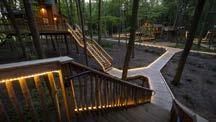

Extended Weekend Getaways
Magazine is Published Monthly by BarnettPRO Publishing Corp. 1515 W. 3rd, Sedalia, Mo 65301
PHONE; 419-687-0002
Email: info@barnettpro.com
Publisher - Michael Arnold Mike@BarnettPRO.com
Editor in chief - Kathy Barnett kathy@extendedweekendgetaways.com
Managing Editor - Norman Reed Norm@extendedweekendgetaways.com
Seasonal Eatings Editor - Kandy Derden kandy@SeasonalEatings.com
Global Editor - Jamie Ye Jamie@extendedweekendgetaways.com
Associate Editor - Robin O’Neal Smith Robin@extendedweekendgetaways.com
Office Staff
Project Director - David Derden David@extendedweekendgetaways.com
Technical Director - Norman Reed Norm@extendedweekendgetaways.com
Website Division:
Bethany Sowash - Kaitlyn Bissen beth@barnettpro.com kaitlyn@barnettpro.com
Marketing & PR: Kathy Barnett Jamie Ye Kelly Redman
Morgan M cHaney
Visit our Website for event coverage between regular issues at www.ExtendedWeekendGetaways.com
Copyright 2024 by BarnettPRO Publishing
All rights reserved. Reproductions of any material from this issue is expressly forbidden without permission of the publisher. Advertisements this publication do not necessarily carry the endorsement of the publishing company.
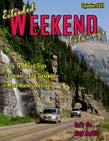
Going To The Sun Road in Montana is one of the top 10 favorite road trips. See the complete article - P. 34.

While this month’s issue focuses on road trips (and Kathy is on one) I am left in the office working overtime. I just saw the following press release with information that is most appropriate to share with you.

The open road beckons with 27 million Americans planning to go RVing this fall and 7.3 million hitting the road over Labor Day weekend alone. The destination of choice for these RV travelers is the journey itself with 65% saying they’re choosing an RV for the road trip.
In a significant shift, RV camping has overtaken rental properties as the preferred accommodation for Labor Day vacationers, according to the latest Fall Travel Intentions survey conducted by Cairn Consulting for the RV Industry Association.
Millennials and Gen Z are driving this surge with 33% of Millennial leisure travelers expressing a desire to take an RV trip in the coming year. Gen Z isn’t far behind, emerging as the most active travelers with keen interests in food tourism and music festivals.
The reason? Escape the daily grind (52%), enjoy destinations at their peak in the fall (48%), seek less crowded experiences (47%), and embrace favorable weather (43%). The love of road trips, visiting family, exploring the outdoors, and traveling in comfort also resonates across all generations. Millennials and Boomers favor fall RVing for the unique experiences the season offers, while Gen X seeks to escape the busyness of everyday life. Gen Z is drawn to the pleasant fall weather.
So use this issue to help plan your next extended weekend getaway with a road trip
Norman Reed Managing Editor

By Robin O’Neal Smith Associate Editor https://RobinOnealSmith.com
Solo travel is on the rise, with more infividuals seeking the adventure and personal growth that comes with exploring the world on their own terms.
Whether you’re a seasoned solo adventurer, an independent explorer, or embarking on a self-discovery quest, the benefits of solo travel are abundant and life-changing.
Having embarked on several solo trips myself, I can attest to the empowering nature of solo travel. There’s a unique sense of freedom in being able to do what you want, when you want, without having to consider anyone else’s preferences.
Let’s look at some of the benefits of solo travel, safety tips for traveling alone, and some outstanding places to experience solo travel.
One of the most celebrated aspects of solo travel is the complete freedom it offers. You can craft your itinerary without compromising destinations, activities, or timelines. This means you can immerse yourself in your interests, whether exploring off-thebeaten-path locales or indulging in local cuisine, all at your own pace.
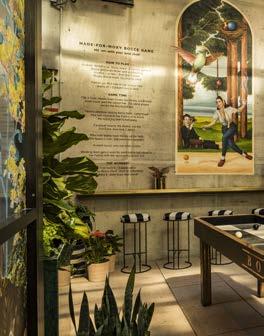
Fellow travel writer Julie Diebolt Price echoed that sentiment when asked what she enjoys about solo travel: “I like to create itineraries that fit me, nobody else. It’s just the things that I like to do and see, and I’m very efficient at routing my trips.”
Navigating new environments alone forces you to step out of your comfort zone, fostering significant personal growth
and self-discovery. Each challenge you overcome boosts your self-confidence and independence, leaving you with a sense of accomplishment and a deeper understanding of yourself.
Solo travelers often find it easier to meet new people and form connections that can last a lifetime. Without the safety net of familiar companions, you’re more likely to strike up conversations with locals and fellow travelers, leading to enriching

experiences and friendships.
4. Enhanced Self-Confidence and Independence
Traveling alone empowers you to make decisions, solve problems, and handle unforeseen situations independently. This independence strengthens your self-confidence, making you more resilient and adaptable in your everyday life.
5. Uninterrupted Introspection and Relaxation
Solo travel provides uninterrupted time for introspection and relaxation. Whether you’re journaling in a cozy café or

meditating on a serene beach, these moments of solitude allow you to recharge and reflect on your life with clarity. Julie mentioned this as well, “I have time to reflect on a lot of things when I’m traveling solo. I reflect on my life, my future goals, my career progress,
volunteer opportunities, future travel destinations, and all the stories I have to tell.”
● Share Your Itinerary: Always share your travel plans and
contact details with a trusted friend or family member.
● Stay Aware: Be mindful of your surroundings and trust your instincts. If something feels off, it probably is.
● Research Local Customs: Understanding local customs and laws can help you avoid unintentional offenses.
● Avoid Isolated Areas: Stick to well-lit, populated areas, especially at night.
● Secure Your Belongings: Use a money belt or secure pockets for valuables and keep a copy of important documents separate from the originals.
● Use Reputable Transportation: Avoid hitchhiking or accepting rides from strangers; opt for trusted transportation services.
● Ensure Secure Accommodation: Choose secure lodging and consider using door stoppers or additional locks.
● Discreet Social Sharing: While staying connected on social media, be discreet about your solo travel status.
● Travel Insurance: Consider travel insurance that covers emergency services, including repatriation in case of illness.
These are just a few of the places offering Solo experiences for travelers.
This charming inn offers a serene retreat, perfect for introspection and relaxation.
Deer Path Inn is a hidden gem for solo travelers about a

half-hour north of Chicago. Its picturesque surroundings and friendly ambiance make it a favorite among solo travelers seeking peace and quiet.
They have the perfect way to relax during a solo stay; a highly personalized package, A Good Book & A Spot of Tea, includes a mystery book hand-selected by the Lake Forest Book Store team. Snuggle up with a new read and sip chamomile tea during a bedtime tea service with English-inspired bedtime snacks, complete with a lavender mocktail and curated “Sleepy Sips” playlist. With elegant accommodations, peaceful surroundings, and experiences that can be enjoyed solo, Deer Path Inn makes a stay for one memorable and relaxing.
Located in the heart of the action, The Darling Hotel provides a blend of luxury and adventure. Its stylish accommodations and prime location make it ideal for independent explorers looking to immerse
themselves in urban experiences.
Sequoia Parks Conservancy is hosting “Hike and Heal Sequoia” as part of its wellness series of weekend hikes (three days) that provide introspective workshops, guided meditations, and transformative exercises. This event is perfect for solo travelers to California who want to experience the beauty of Sequoia National Park, home to the largest living thing on earth—the giant sequoia trees. Once the

outdoor experience is completed, ease your return to the real world with a pampering stay at The Darling Hotel in downtown Visalia.
Visalia is the gateway community to Sequoia and Kings Canyon National Parks and is located three hours north of Los Angeles and about 3.5 hours south of San Francisco.
AKA Sutton Place, New York
For those craving the hustle and bustle of city life, AKA Sutton Place in New York, offers upscale living with a touch of home. It’s an excellent base for solo adventurers keen on exploring the city’s vibrant culture and iconic landmarks.
AKA Sutton Place , NYC
They just launched a new package/program, the AKA Sabbatical Retreat, that’s perfect for solo travelers visiting New York!
Ideal for the discerning solo traveler who values peace and comfort in the heart of the city,

the AKA Sabbatical Retreat includes a luxurious 30-night stay in a sophisticated suite, an exclusive mindfulness workshop with Marianna Cuomo Maier of Grata Wellness, and tickets to the Guggenheim or Metropolitan Museum of Art. Guests also receive a welcome basket of gifts, including an AKA baseball cap, a journal, and a disposable camera to capture and document their enriching experiences.
Moxy Hotels in NYC are known for their trendy, social atmosphere. These hotels offer a perfect blend of comfort and community, making them an excellent choice for solo travelers who enjoy mingling with others while having a stylish place to stay.
The Moxy Hotels in Times Square, Chelsea, East Village, Lower East Side, and Williamsburg all incorporate safe spaces and practices ideal for solo travelers.
At each property, they leverage their public spaces to create smaller alcoves where solo guests may sit by themselves, along with a hotel’s bar having the ability to serve meals, as opposed to being a place only for drinks, for people
who want to have a quick bite in the lobby. Each property has also been designed to have functional, co-working spaces, including a communal table that is comfortable and inviting for all.
Each property offers diverse guest programming and amenities each month that they can appreciate and make them feel less alone.
Solo travel isn’t just a trend but a transformative experience offering unparalleled freedom, personal growth, and new connections. Whether exploring serene inns or bustling city hotels, remember to prioritize safety and savor every moment of your journey.

By Robin O’Neal Smith Associate Editor
The Hotel Elkhart, Tapestry Collection by Hilton offers an exquisite blend of luxury and comfort, ensuring a memorable stay for all its guests. From the moment you step inside, you’ll experience an ambiance that makes you feel right at home, coupled with a welcoming atmosphere, friendly service, and topnotch amenities.
I visited with two other ladies as part of a “girl’s trip” in July.

Hotel Elkhart hosted our stay. All opinions are my own.
I was impressed by the warm welcome and efficiency of the staff at the Hotel Elkhart. The check-in process was smooth, and the staff’s friendly and confident demeanor made me feel comfortable and at ease. Their attentiveness and willingness to assist with any queries set the tone for a delightful stay.
I also loved the living wall mural behind the check-in counter. It depicted the Elkhart area and the island, which was said to look like an elk heart, hence the town name. The living wall mural in
cluded moss, succulents, other plants, and blue epoxy resin representing the rivers. It was impressive.
The lobby of Hotel Elkhart exudes an elegant and welcoming atmosphere, with its modern design and plush seating. Natural light fills the space and shines on the original terrazzo.

The guest rooms at Hotel Elkhart are nothing short of spectacular. They are spacious, wellequipped, and tastefully decorated in contemporary navy blue
and grey tones. The high-quality bed linens and mattresses add a touch of luxury. Window treatments included shade blinds and darkening blinds.
Artwork on the walls complements the color scheme, creating a fresh and inviting environment.
The bathrooms are a standout feature, with their expansive layout, marble finishes, and large walk-in showers featuring rainfall showerheads. The plush towels and complimentary Molton Brown toiletries further enhance the experience.
The fitness center is well-maintained, making it easy for guests to stick to their workout routines. The High Note rooftop bar offers stunning views and a great selection of beverages, perfect for unwinding after a busy day. Guests can enjoy parking in the neighboring parking garage.

Depending on the room, guests can enjoy views of the city skyline or nearby attractions. The High Note rooftop bar offers panoramic city views, making it a popular spot for guests to relax and enjoy
Hotel Elkhart features two on-

site restaurants that cater to a variety of tastes. The Relish, open for breakfast and lunch, offers a diverse menu of traditional breakfast food, salads, and sandwiches. The Corner Bar, open for dinner, serves up delicious appetizers, and entrees. The food at both restaurants is not only delicious but also beautifully presented, and the attentive service enhances the dining experience.
The staff at Hotel Elkhart are not just friendly, but they also make you feel genuinely valued as a guest. Their welcoming and attentive nature, coupled with their consistent efforts to ensure your comfort, is a testament to their exceptional service.
The hotel’s strategic location, with easy access to local attractions, is a major convenience.
Whether you’re here for business or leisure, you’ll find everything you need within a short distance allowing you to relax and enjoy your stay without the stress of long commutes.
We could walk to museums, restaurants, the Lerner Theater, a concert, shops, the Riverwalk, and more. Elkhart River Greenway Trail, riverfront parks, and Wellfield Botanic Gardens are less than one mile from us. The University of Notre Dame is 30 minutes away.
Address: Hotel Elkhart, 500 S. Main St, Elkhart, Indiana 46516
My stay at Hotel Elkhart exceeded my expectations. The combination of luxurious accommodations, exceptional amenities, and outstanding service makes it a top choice for anyone visiting the area. I highly recommend Hotel Elkhart to anyone seeking a memorable stay.

Imagine a road that vanishes beneath the waves, only to reappear twice a day, inviting you to cross before it disappears again. Welcome to Passage du Gois, a captivating causeway in France that offers a unique road trip adventure like no other. Located on the Atlantic coast in Bourgneuf Bay, this 2.6-mile-long road connects the town of Beauvoir-sur-Mer to the enchanting island of Noirmoutier.
Timing is everything on this journey, as the Passage du Gois is only accessible for a limited window: one and a half hours before and after low tide. During this time, travelers can drive across the causeway, shaving 20 minutes off the time it would take to reach Noirmoutier using the alternative Noirmoutier Bridge. However, when the tide rises, the road is engulfed by 4 to 13 feet of water, making it disappear until the next low tide.
Planning ahead is essential,
and the Noirmoutier tourist office provides a real-time tidal table to ensure a safe crossing. Despite its fleeting nature, the road attracts thousands of visitors each year. In 2021 alone, 387,823 crossings were made, solidifying Passage du Gois as a bucket list destination for many. One traveler described it as “beautiful, powerful, unique, and spectacular,” while another marveled at the experience of seeing it at high tide and then driving across it at low tide.
The history of Passage du Gois is as fascinating as its disappearing act. Millions of years ago, intersecting ocean currents deposited enough silt to create a natural passageway between Noirmoutier Island and the mainland. The first recorded mention of the causeway dates back to 1689 by military engineer Sébastien Le Prestre, Marquis de Vauban, and it appeared on a map in 1701. Over the centuries, the road was reinforced
with buoys, foundations, stone walls, and ramps, eventually being paved and widened in the 1930s to enhance the traveler experience.
Passage du Gois is more than just a road; it’s a venue for special events that add to its allure. The causeway has been featured in the Tour de France twice, in 1999 and 2011, and hosts the annual Les Foulées du Gois race, where thousands of runners dash across the wet expanse. In 2024, the road was part of the Olympic torch tour for the Paris Games. Luxury car brand Porsche also tested its “Wet Mode” feature here, highlighting the road’s unique conditions.
Despite its beauty, Passage du Gois is known as one of the world’s most dangerous drives, due to the risk of being caught by the tides. To ensure safety, rescue towers are strategically placed along the road for those who might find themselves stranded.
Think of All-American Roads as National Scenic Byways on steroids. These wholly American thoroughfares pass through 28 states, and automotive travelers can expect extra special features – beyond natural beauty – when they explore them. With fall season fast approaching, the road trip experts at Roadtrippers have compiled a list of their favorite routes to explore when the trees change color and the temperatures take a dive.
Roadtrippers is the No. 1 road trip planning app, helping people experience the world around them in an entirely new way by streamlining discovery, planning, booking and navigation into an engaging and intuitive process. Roadtrippers has helped millions of users plan more than 38 million trips across 7 million locations.
“America’s roads are the envy of the world because car travelers have an up-close view of some of the most beautiful and historically significant places on the planet,” said Mary Heneen, CEO of Roadpass, the parent company of Roadtrippers.
To be designated a scenic byway, roads must have one of six intrinsic qualities: archeological, cultural, historic, natural, recreational or scenic. All-American Roads must have
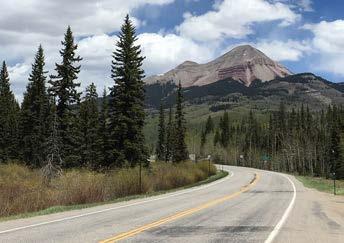
two of those qualities, making these routes extra special. While both National Scenic Byways and All-American Roads must be designated by the Scenic Byways division of the Federal Highway Administration, becoming an All-American Road means that travel on that road is a major part of the travel experience, or a “destination unto itself.” In other words, it’s not just another road with pretty scenery.
As of 2021, the last time the Federal Highway Administration added to its lineup of Scenic Byways, there are 150 Scenic Byways but only 37 All-American Roads.
One of the latest features, introduced this spring, is the app’s new Autopilot feature, which uses patent-pending AI tech-
nology to allow users to customize their road trips based on their personal travel style.
The feature is especially useful to travelers planning multiday trips, as the app helps find accommodations that suit travelers’ needs, and it identifies roadside stops – called Extraordinary Places – that travelers can select based on their interests.
“By analyzing the data gathered through Autopilot, especially the stops travelers want to make along the way, we can clearly see that the vast number of our users think of the road trip as part of the experience and not just necessary car time to get to their destination,” noted Heneen. To learn more about Roadtrippers, visit www.roadtrippers.com.

McKINNEY, Texas – The City of McKinney and Visit McKinney are proud to announce The Courts of McKinney at Gabe Nesbitt Park will host the Billie Jean King Cup by Gainbridge Play-off between the top women’s players from Ukraine and Austria on Nov. 16-17.
“The City of McKinney is honored to host the Billie Jean King Cup Play-off, an event that brings not only top-tier tennis to our community but also significant economic benefits,” said Mayor George Fuller. “Hosting a tournament of this caliber showcases our world-class facilities and puts McKinney on the global stage. Moreover, we are proud to provide a home for the Ukrainian team during such a challenging time, demonstrating our city’s commitment to supporting recreation and cultural exchanges.”
The competition will be a best-of-five match series and one of eight held worldwide in November. The winners will advance to the Billie Jean
King Cup Qualifier by Gainbridge next April. The play-off begins Saturday, Nov. 16, with two singles matches. Two reverse singles matches and a doubles match will follow on Sunday, Nov. 17. If one nation clinches victory in the third or fourth singles match, the schedule will be amended.
“This international event reflects McKinney’s dedication to fostering sports tourism and enhancing our city’s profile as a premier destination for world-class events,” said Aaron Werner, Director of Visit McKinney. “We’re proud to welcome athletes and fans from around the globe, who will not only experience our exceptional facilities and hospitality but also contribute to our local economy by staying in our hotels, dining in our restaurants, and shopping in our stores.”
The Courts of McKinney opened the new $11 million indoor tennis complex at Gabe Nesbitt
Community Park in 2023. The six indoor courts are next to the existing outdoor tennis facility, bringing the total number of courts within the complex to 29. The building includes training rooms, administrative offices, locker rooms, and a second-level viewing mezzanine, creating one of the premier public tennis facilities in the country. With the completion of the new indoor facility, the city has been pursuing more largescale tournaments for all ages and skill levels.
“I am so excited to be part of this opportunity at The Courts of McKinney to bring a world-class international tennis event back to North Texas,”
said Elina Svitolina, the current top-ranked player from Ukraine who was ranked No. 3 in the world by the Women’s Tennis Association. “Of course, our dream would be holding our home tie in Ukraine, as it has always been, but during the war, it is not possible.”
Tickets and VIP hospitality packages will be available to the public starting at 9 a.m. on Aug. 17. All proceeds from the play-off will benefit the Svitolina Foundation and the Bush-Wikse ACE Outreach Program, supporting children worldwide with access to tennis equipment, programs, and other resources.
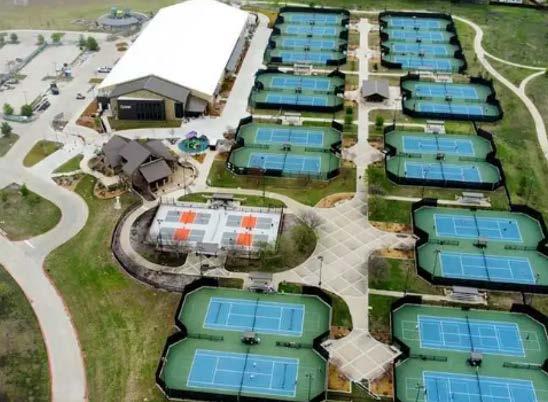

The American-inspired chocolate muffin is what took the gold medal and went viral on social media. Olympian Henrik Christiansen sparked the Chocolate Muffin Craze with Google searches Exceeding 1,500%
Norwegian swimmer Henrik Christiansen has whipped up a global chocolate muffin frenzy. According to data from QR Code Generator, worldwide searches for “chocolate muffins” have surged by a staggering 1,523% since Christiansen began sharing his love for the treats on social media.
The Olympic athlete competing in the Paris 2024 Games has become an internet sensation thanks to his viral TikTok videos showcasing his obsession with Olympic Village
muffins. He has since been dubbed “muffin man” after featuring the “choccy muffin,” accumulating millions of views. He gave it an “insane” 11/10 star review.
QR Code Generator also discovered his growing fame has not only boosted his follower count by over 250,000 in the past month but has also ignited a baking boom, with searches for “chocolate muffin recipes” jumping 203%.
It is estimated he can earn up to $700 per sponsored post with his current engagement metrics.
Commenting on the findings, Marc Porcar, CEO of QR Code Generator PRO S.L, said:
“Henrik, Norway’s swimming sensation, has created
a worldwide stir—but not in the pool. His viral love for Olympic chocolate muffins has seen celebrities like Gordon Ramsay chime in and people around the world desperately trying to crack the secret recipe.
With newfound fame as the ‘Muffin Man’, it is a delightful reminder that even the greatest athletes are human. Seeing a world-class athlete like Henrik become an internet sensation for something as relatable as a love of delicious food is incredibly endearing.”
The study analyzed Google Trends data for worldwide searches of “chocolate muffins” over the past 90 days and calculated the percentage increase.

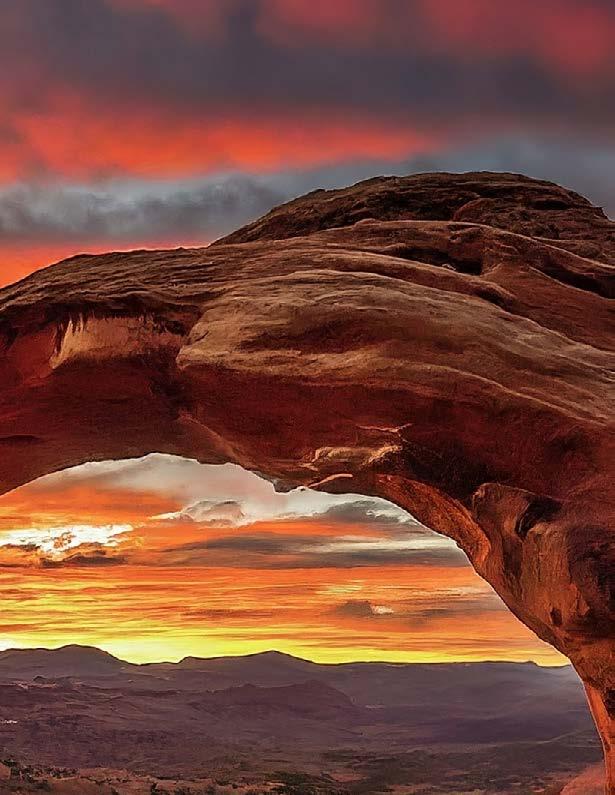


Arizona offers some of the most scenic and diverse road trip experiences in the United States, where the journey itself often becomes the highlight of the adventure. From the iconic Route 66 to the breathtaking Oak Creek Canyon and the historic Apache Trail, every mile traveled in Arizona unfolds like a scene from a cinematic masterpiece.
Starting with Route 66, often referred to as the “Main Street of America,” this legendary highway stretches through Arizona, passing through charming small towns like Seligman and Kingman, where nostalgia for the golden age of road travel is palpable. As you drive along this historic route, you’ll encounter classic roadside attractions, vintage motels, and diners that have preserved the spirit of the 1950s.


Oak Creek Canyon, located near Sedona, offers a different kind of beauty with its lush forests, red rock formations, and the tranquil waters of Oak Creek. The winding road through the canyon provides ample opportunities to pull over and soak in the stunning vistas or take a hike along one of the many trails. The drive is particularly enchanting during the fall when the foliage transforms into a vibrant tapestry of reds, oranges, and yellows.
For those seeking a more rugged adventure, the Apache Trail Historic Road is a must-drive. This narrow, winding road was once a stage-
coach route, and it offers unparalleled views of the Superstition Mountains, deep canyons, and desert lakes. The drive can be challenging, with steep grades and sharp curves, but the reward is a journey through some of Arizona’s most untouched and awe-inspiring landscapes.
Whether you’re a history buff, a nature lover, or simply someone looking to escape into the wild beauty of the Southwest, Arizona’s roads promise an unforgettable road trip experience. Every twist and turn reveals a new perspective, making the journey just as memorable as the destination.
More on Arizona >HERE



By Julie Diebolt Price Freelance Travel Writer
The Pacific Coast Highway, aka California State Route 101 and 1, is renowned as one of the most scenic drives in the world. A Pacific Coast Highway road trip offers stunning ocean views, picturesque coastal towns, and a variety of natural and cultural attractions. It runs from the border of Washington and Canada to Southern California and the border of Mexico, about 1,600 miles.
These are my favorite stops on an exciting California Pacific Coast Highway road trip.
Spring and fall are the best times to take a scenic Pacific Coast Highway road trip. Dense fog occurs in the summer months, along with tourists and traffic.
To enjoy the best coastline view, start in Northern California, and you will be driving on the right side of the road going south. Pulling out for the breathtaking views, returning to the highway, and moving traffic will be easier.

CRESCENT CITY - From Crescent City, drive through the Redwood National and State Parks, known for the tallest trees on Earth. Eighty-five miles of rugged coastline leave a lasting impression.
Lush forests in Humboldt County reach the rocky coast at Patrick’s Point, Trinidad, Eureka, and Humboldt. Go agate hunting, tidepool exploring, spot seals and sea lions, hike trails to waterfalls, and watch migrating whales. Thrilling drives include Avenue of the Giants, Redwood Highway, Lost Coast Scenic Drive, and the Shrine Drive-Through Tree.
FORT BRAGG - Fort Bragg, founded in 1857 before the American Civil War, is a California Historical Landmark. While there, visit Glass Beach, take a historic Skunk Train ride, and a Railbike Tour to Pudding Creek.


man’s Wharf, and Chinatown.
MONTEREY- Monterey offers a mix of natural beauty and historical significance. Visit the famous Monterey Bay Aquarium and Cannery Row.
MENDOCINO is a quaint, seaside town with New England-style architecture. The Mendocino Historic District is listed on the National Register of Historic Places.
POINT ARENA - The Light Station hosts overnight guests, including a free tower tour, access to the Light Station Store, and indoor and outdoor museums.
SAN FRANSCISCO - This iconic city offers countless attractions, including the Golden Gate Bridge, Alcatraz Island, Fisher-
CARMEL-BY-THE-SEA - Scenic beauty and beaches are the hallmark of Carmel-By-TheSea. The world-famous 17-Mile Drive is a scenic road through Pebble Beach and Pacific Grove with the iconic Lone Cypress landmark, worldclass golf courses, and art galleries.
BIG SUR - One of the Pacific Coast Highway’s most scenic and dramatic stretches is through Big Sur. The rugged coastline, towering redwoods, and iconic landmarks like Bixby Creek Bridge and McWay Falls highlight this trip.
SAN SIMEON - The most notable attraction in San Simeon is Hearst Castle, a National Historic Landmark. Built by William Randolph
Hearst, the newspaper magnate, the castle is open for tours showcasing stunning architecture, outdoor and indoor pools, luxurious rooms, beautiful gardens, and an extensive art collection.
MORRO BAY - Morro Rock, the iconic 576-foot volcanic plug at the entrance to Morro Bay, is known as “The Gibraltar of the Pacific,” is a state historic landmark and a protected bird sanctuary.
SAN LUIS OBISPO - San Luis Obispo, often called SLO, is home to the quirky Bubblegum Alley and the historic Mission San Luis Obispo de Tolosa.
SANTA BARBARA - Known as the “American Riviera,” Santa Barbara boasts Spanish-style architecture, beautiful beaches, and a vibrant arts scene. Key attractions include the Santa Barbara Mission, Stearns Wharf, and State Street for shopping and dining.
VENTURA offers a more laid-back atmosphere with its historic downtown, Ventura Pier, and the nearby Channel Islands National Park.
MALIBU - Driving through Malibu, you’ll be treated to stunning ocean views and luxurious beach homes. Popular stops include Zuma Beach, Point Dume State Beach, and the Getty Villa, which has an impressive collection of ancient art.
SANTA MONICA - is home to the famous Santa Monica Pier with its Ferris wheel, aquarium, and numerous restaurants. The nearby Third Street Promenade is a shopping and entertainment hub.
TORRANCE - is home to one of the largest shopping malls in the U.S.–the Del Amo Shopping Center. Historic Old Town Torrance is known for its unique shops, restaurants, and historic buildings. We enjoyed craft beer, an elevated tea experience, and delicious baked goods in Old Town.
SEAL BEACH - Seal Beach has a quaint, smalltown feel and is perfect for leisurely walks, superb dining, and shopping.
One of the longest wooden piers in California is the Seal Beach Pier. Surfing is popular near the pier.

HUNTINGTON BEACH - Known as “Surf City USA,” Huntington Beach is a haven for surfers and beach lovers. The iconic Huntington Beach Pier and the International Surfing Museum are must-visits.
NEWPORT BEACH - Known for upscale living, Newport Beach is ideal for surfing, sunbathing, swimming, and beach volleyball. Crystal Cove State Park and Upper Newport Bay Nature Preserve offer hiking trails, biking, bird watching, kayaking, and tidepools.
Balboa Peninsula is home to the iconic Balboa Pier, with a lively boardwalk and a 900-foot ferry ride to Balboa Island.
LAGUNA BEACH - A great place to stroll Main Beach, visit the Laguna Art Museum, or enjoy outstanding dining. Summer brings the world-famous Pageant of the Masters, Sawdust Art Festival, Festival of Arts, and Laguna Art-A-Fair.
DANA POINT - In Orange County, Dana Point marks the beginning or


end of the Pacific Coast Highway. This coastal city is known for its beautiful harbor, the Dana Point Headlands, offering spectacular views and hiking trails.
DANA POINT to SAN DIEGO - South of Dana Point, Highway 1 connects to Interstate 5 Freeway, which takes you along the coast to San Diego.
Take your time to savor each destination on your Pacific Coast Highway road trip, and you’ll have a deeper appreciation for the spectacular Pacific Coast.

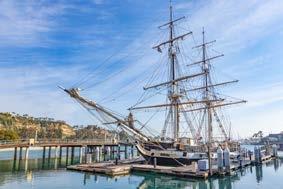




B Carmen Varner Freelance Writer
The city of SLO is an ideal destination for nature lovers who want to spend time outdoors or off the beaten path. From creekside meals to hiking trails, there’s a bit of everything for adventurers to enjoy. It’s also a place for all ages. You’ll see families pushing strollers with tired tots, college students, retirees, and others walking around. There’s no shortage of cozy things to see, eat, and do in the area.
Visit San Luis Obispo hosted me, but all opinions are my own.
Get a bit of sunshine as you stroll SLO’s many footpaths and scenic routes. Poly Canyon, also known as the Architecture Graveyard, has trails and unique architectural structures built by students. This spot makes it a fantastic place to ramble and

take in the art in a place you wouldn’t expect.
The dog-friendly Cerro San Luis Natural Reserve has three routes you can wander, such as the Lemon Grove Loop trail. Inhale and exhale a deep breath of the fresh air as you hike or mountain bike through the trails. Bob Jones Trail, also called “City to the Sea” Trail, welcomes hikers,
joggers, and cyclists alike to soak in the Avila Valley and San Luis Obispo Creek.
For something shorter, roam the Terrace Hill Open Space, which is less than a mile round trip. It’s the ideal trek when you don’t have much time but still want panoramic views of San Luis Obispo. Sit on one of the benches as you marvel at the

surroundings.
You’ll find that SLO has several parks if you’re looking for a more lowkey outdoor experience. Bring your pup to El Chorro Dog Park for a walk or venture to Hardie Park for a picnic or to let the kids play. Take photos of the children on the swing set at Cuesta Canyon Park with the mountain in the background.
Leaning Pine Arboretum, at the California Polytechnic State University, San Luis Obispo campus, is an incredible place to relish the great outdoors. Appreciate the nearby coastal mountains, redwood grove, flowering plants, and attractive landscapes.
You don’t have to navigate to Napa for exceptional wine. From Autry Cellars to El Lugar Wines, San Luis Obispo has a booming wine industry thanks to the city’s growing conditions. If you don’t necessarily want to drive around to explore
the range of wines, a wine bar is your best bet.
Opt for Region, a wine bar with over 50 local wines from over 35 wineries. Region develops relationships with local winemakers and has a self-serve technology that allows you to pick from tasters, half pours, or full pours. Try a few wines without hopping from one place
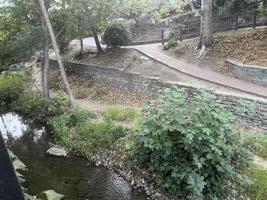
of choice, head to The Hub SLO, where you can choose between Central Coast Brewing and Krobar Craft Distillery. Central Coast Brewing’s section has a large outdoor space with views of the mountains.

to the next. Sit alfresco on a couch or choose the indoor seating near the open windows so you can peer outside.
If wine isn’t your beverage
Savor an outdoor meal by a creek and trees at Novo Restaurant & Lounge. The outdoor patio has a beautiful, buzzing atmosphere as guests dine and drink. They have a comprehensive menu that includes Saturday brunch, lunch, dinner, drinks, and kids. Don’t leave without trying a dessert. The baklava cheesecake—honey-goat

cheese cheesecake, graham cracker crust, phyllo pastry, crushed pistachios and walnuts, rose water syrup, and dried rose petals—was remarkable.
Mistura Restaurant offers a reenergized approach to Peruvian cuisine, highlighting Incan and Pre-Columbian dishes while blending other influences. Led by chef Nicola Allegretta, the restaurant prioritizes sustainability, using organic produce and locally-sourced meat and fish for a farm-to-table dining adventure. The menu reflects the nature focus with entrees split into Costa (From the Sea) and Sierra (From the Mountains).
The Thursday evening farmers market is a sight to behold spanning five blocks with 100 vendors. There’s produce, BBQ, baked goods, entertainment, and more for tourists and locals to check out.
Stay at the Apple Farm Inn, located at 2015 Monterey St, San Luis Obispo, CA 93401, for a quaint place to relax. The inn has complimentary amenities such as daily cookies, wine samples, coffee, tea, and apple cider. Once you check in, ask about the timing or grab the information sheet from the front desk.
Pour yourself a cup of cof-
fee and take a crisp morning stroll through the property to admire the trees and flower garden while birds chirp. In the afternoon, sit at an outside table to sip your wine with a view of the mountains behind. Apple Farm Inn also has an on-site restaurant and the Apple Farm Cellar, where you can purchase wine.
SLO also has alluring beds and breakfasts, ideal for romantic and restful stays. La Lomita Ranch at 1985 La Lomita Way brings Spanish charm and peaceful views for guests. It’s a fantastic wedding spot, but it has a range of room accommodations based on your party size, whether you’re visiting for a couple’s holiday or with family.
Leisurely stroll the downtown SLO area for food, drinks, and all sorts of souvenirs. It’s the perfect way to appreciate the autumn temperatures.
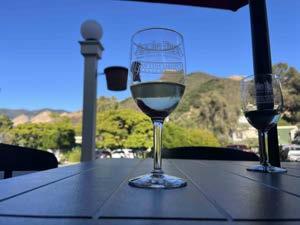
This route lives up to its name with breathtaking views and rich history. Winding through the heart of the Rocky Mountains, spanning from Ouray to Silverton, the highway takes you through challenging terrain, soaring mountain passes, and the remnants of old mining towns, offering a glimpse into the region’s storied past.
Start your adventure in Ouray showing off a stunning box canyon setting. Among towering peaks, Ouray exudes a charming, smalltown atmosphere with a historic main street that transports you back to Wild West days.

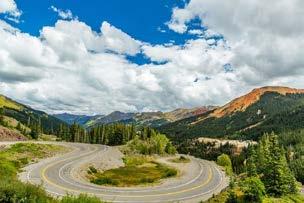
this drive, stopping at various lookout points to fully appreciate the rugged beauty of the San Juan Mountains. If time permits, stop at one of the many remnants of mining operations that dot the landscape, offering a peek into Colorado’s gold and silver rush era.
Stroll along Main Street, where beautifully preserved 19th-century buildings now house boutique shops, local galleries, and quaint cafes. History enthusiasts will appreciate a visit to the Ouray County Historical Museum, which showcases artifacts and stories from the town’s mining days.
After soaking in the town’s charm, reward yourself with a visit to the famous Ouray Hot Springs. These geothermal heated mineral pools are the perfect way to unwind and relax, offering stunning views of the surrounding mountains while you soak in the naturally warm waters.
After a restful night in Ouray, continue your drive along the winding road with spectacular views around every bend.Take your time on
As you descend into Silverton, you’ll find a place that feels untouched by time. Silverton’s well-preserved historic district, with its dirt roads and vintage buildings, will make you feel like you’ve stepped into a Western movie set. Enjoy a leisurely afternoon exploring antique shops, indulging in a meal at a local restaurant, and chatting with the friendly locals.
For those who crave more adventure, Silverton is a gateway to outdoor activities. From hiking and mountain biking to off-road Jeep tours, there’s something for every thrill-seeker. If you’re visiting in winter, the nearby Silverton Mountain offers world-class skiing for the adventurous at heart.
The Million Dollar Highway is a journey filled with the best of the Rocky Mountains.


By Lisa Garcia Staff Journalist
Imagine cruising along a winding road with lush tropical scenery unfolding at every turn, waterfalls cascading down verdant cliffs, and the scent of the ocean mingling with the sweet fragrance of tropical flowers. This isn’t a scene from a movie; it’s the unforgettable experience of driving the Hana Highway — a must-do for any family road trip.
Stretching 64 miles from the bustling town of Kahului to the tranquil village of Hana, the Hana Highway is more than just a road; it’s an adventure that draws in more than 60,000 monthly online searches, with travelers eager to witness its breathtaking beauty. The highway meanders through the eastern coast of Maui, offering a feast for the senses with every twist and turn.

As you set out from Kahului, the landscape quickly shifts from urban to tropical. The road is narrow and winding, with over 600 curves and 50 bridges, many of which are single-lane, adding a touch of excitement to the drive. But it’s the scenery that will have your family in awe—towering bamboo forests, vibrant rainbow eucalyptus trees, and ocean vistas that stretch as far as the eye can see.
One of the highlights of the Hana Highway is the abundance of waterfalls. Whether you’re stopping at Twin Falls, the first easily accessible waterfall along the route, or making your way to Wailua Falls near the end of your journey, the sound of rushing water and the sight of shimmering cascades will be a delight for both kids and adults. Pack your swimsuits because many of these falls have inviting pools perfect for a refreshing dip.

No trip along the Hana Highway would be complete without a visit to the Seven Sacred Pools, or ‘Ohe’o Gulch, located in the Kipahulu District of Haleakalā National Park. These tiered pools are fed by waterfalls and are surrounded by lush greenery, offering a serene spot to relax and enjoy nature. The park also has several hiking trails, perfect for families looking to stretch their legs and explore more of Maui’s natural beauty.
The town of Hana is the perfect endpoint for your road trip. This sleepy village feels like a step back in time, with its unspoiled beaches, local food stands, and welcoming atmosphere. Take the time to ex-
plore Hana Beach Park, where the black sand beach offers a unique spot for picnicking and playing in the surf. Or, venture a bit further to the Wai’anapanapa State Park, home to more black sand beaches, sea caves, and coastal trails.
While the Hana Highway is a relatively short drive, it’s best to take your time and make it a full-day adventure. Start early to avoid crowds, and be sure to pack plenty of snacks, water, and a camera to capture the stunning scenery. Also, don’t forget to fill up your gas
tank in Kahului—there are few gas stations along the way.
The Hana Highway isn’t just a road; it’s an experience that will leave your family with memories to last a lifetime. From the thrill of the drive to the awe-inspiring landscapes and the tranquility of Hana, this journey is the perfect way to immerse yourself in the natural wonders of Maui. So pack up the car, grab the kids, and set out on an adventure that’s sure to be the highlight of your Hawaiian vacation.
More in Hawaii >HERE
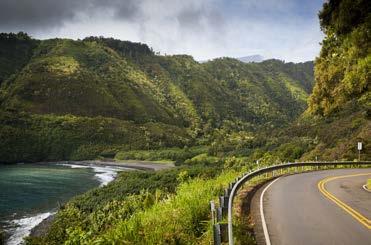


By Robin O’Neal Smith Associate Editor RobinONealSmith.com
Imagine a road where every turn reveals a new and awe-inspiring vista of towering peaks, pristine lakes, and abundant wildlife. Welcome to Beartooth Highway, one of America’s most scenic drives. This iconic road trip through Montana promises a blend of adventure and tranquility, making it a must-visit for any travel enthusiast.
My husband introduced me to this majestic road trip in the 1980s. We have since roadtripped over the Beartooth several times. The experience is always awe-inspiring and sometimes nail-biting.
The entire trip is about 120 miles. It can be done in several hours if you drive straight through. But there are many stops, possible hikes, and side trips along the way, and to totally enjoy the trip, I recommend spending

two or three days crossing over the ragged pinnacle known as the Beartooth.

This highway is usually open from Memorial Day to mid-October. Check the weather forecast and road conditions before setting out, as they can change rapidly in the mountains, even during summer. During one of our visits, we woke up to four inches of snow in June.
In this article, we’ll take you through a detailed itinerary, sharing personal experiences, travel tips, and hidden gems to help you make the most of your Beartooth highway expedition.

Our adventure begins in Columbus on the banks of the Yellowstone River. (If you plan to hike along the way, be sure to take water and a picnic lunch.) Taking Route 78, you will head south and skirt the northern edge of the Beartooth Mountain Range. You will passAbsarokee, formerly Crow Indian territory.
Continuing on Route 78 along the creek, you will arrive at Roscoe, where the creek and the road part ways. Here, you have a couple of choices. Continue on Route 78 towards Red Lodge, or take Route 177 along the waterway into the wilds (this takes you on dirt roads), ending at East Rosebud Lake, a hiker’s heaven. There are two trails, one into the mountains and one along the creek.
Route 78 climbs over 1,000 feet on its way to Red Lodge. You will see creeks, waterfalls tumbling from
cliffs, and wildflowers along the way. This is a stunning drive, so be sure to have your camera ready.
If breaking the trip up into multiple days, you can spend the night in Red Lodge, Montana. Known for its historic downtown and friendly locals, Red Lodge is where you need to stop and top off your gas tank, have a delicious meal, and stock up on supplies before the next leg of your trip. (There are limited options along the route for gas and food.)
Red Lodge is considered the eastern terminus of the Beartooth Highway.
Starting your ascent on the Beartooth Highway, the initial climb is breathtaking. The following 68 miles are full of switchbacks, and each turn reveals a new, stunning view as the road continues to higher elevations. The air gets crisper, the scenery more dramatic, and the excitement builds as you approach the Beartooth.
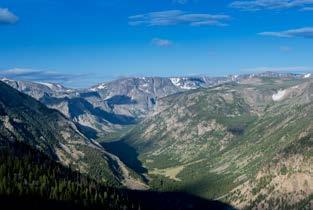

Perched at an impressive 8,000 feet on the Beartooth Highway, Rock Creek Vista Point offers visitors an unparalleled panoramic view of Rock Creek Canyon and the winding road ahead. This breathtaking vantage point immerses you in natural beauty, with wildlife sightings adding to the allure.
Whether catching a glimpse of soaring birds or observing the local fauna, the experience is spectacular. Expect to be captivated by the stunning vistas that stretch as far as the eye can see, making it a must-visit spot for nature lovers and photography enthusiasts alike.
Next, you will cross from Montana into Wyoming and head to Gardner Lake, another tranquil location ideal for unwinding. Whether you’re into fishing, hiking, or simply lounging by the water, Gardner Lake offers a peaceful escape from the more adrenaline-pumping parts of the trip.
If you like hiking, the Beartooth Loop National Recreation Trail (10 miles) begins at Garner Lake. This trail includes a stretch of alpine tundra similar to that near the Arctic Circle.
The drive through Beartooth Pass is both exhilarating and awe-inspiring. The narrow, winding roads and steep inclines can be challenging, but the rewards are well worth it. Sheer drops and towering cliffs accompany you on either side, creating a sense of adventure that’s hard to match. The crest of the byway is 10,947 feet above sea level, making it one of the world’s highest roads. Each overlook along the pass offers unique perspectives of the dramatic landscape. Some places have visibility of 76 miles. Glacier-etched valleys and snow-capped peaks can be seen.
Be sure to make frequent stops to appreciate the views and give yourself a break from the intense driving conditions. There are plenty of pull-off areas along the highway. Avoid strenuous activi-
ties at high altitudes.
Perched at over 10,000 feet, the Top of the World Store is aptly named. This small but welcoming store offers snacks, souvenirs, and some of the most spectacular panoramic views you could imagine. Standing there, surrounded by snow-capped peaks, it’s hard to believe you’re still in the U.S. Take a moment to soak it all in before continuing your drive.
They also have a four-room motel if you want to spend the night there and make it a three-day adventure.
As you descend the mountain, you will see shimmering Beartooth Lake. The lake is an excellent place for a picnic lunch or short hike. Enjoy all the natural beauty. The clear, calm waters reflect the surrounding mountains, creating picture-perfect moments at every turn. This is an excellent area for photos. Beartooth Falls is on the opposite side of the highway, with water plunging over 100 feet— another excellent photo opportunity.
Park.
To make your road trip even more memorable, explore some local hidden gems along Beartooth Highway:
● Lesser-Known Hiking Trails: Try the Lake Fork Trail or Hellroaring Plateau Trail for stunning views without the crowds.
● Local Fishing Spots: Spend a peaceful afternoon fishing for trout in the numerous streams and lakes along the highway.
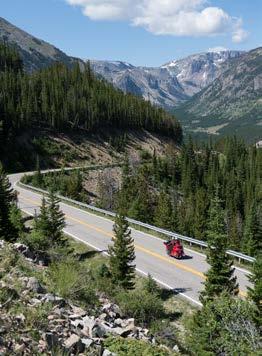
Going up Beartooth Mountain
Submitted by Montana Office of Tourism and Business Development
The highway winds through Wyoming and crosses onto the Colter Pass back into Montana. This area is where you will see lots of wildlife. Watch for deer, black bears, moose, and eagles. You can rejoin civilization again at Cooke City or Silver Gate. You are just a few miles from the northeastern entrance to Yellowstone National
● Historic Sites: Visit the ghost town of Kirwin to glimpse Montana’s mining history.
● Wildlife Watching: Look for bighorn sheep, grizzly bears, and other wildlife that call this area home.
●Stargazing: Take the chance to stargaze at night. The high elevation and clear skies provide an unforgettable celestial experience.
Reflecting on the entire Beartooth Highway expedition, it’s clear why this route is hailed as one of America’s most scenic drives. From the breathtaking initial climb up Scenic Route 78 to the serene beauty of Beartooth Lake and Gardner Lake, every moment of the trip offers a new perspective on Montana’s natural splendor.
The Beartooth Highway awaits, ready to offer you an experience that’s as exhilarating as it is memorable. Pack your bags, check your gear, and get prepared to unveil Montana’s majesty for yourself.
More on Montana >HERE


By Robin O’Neal Smith Associate Editor RobinONealSmith.com
Completed in 1932 andrecognized as one of the most stunning drives in North America, this engineering marvel invites travelers to explore its rich historical and cultural tapestry. Named after the Blackfeet Nation’s deity, Napi, the road embodies a deep connection between nature and human heritage.
“Spanning across 50 miles of scenic splendor in Glacier National Park, MT., Going-to-the-Sun Road is more than just a route — it’s an experience. “

My husband and I road-tripped this passage a few years ago. The views were impressive, and we hope to return soon and do it again. Read on as we unveil the hidden gems along this unforgettable mountain passage.
We will enter on the west side of the park at West Glacier. From 6 a.m. to 3 p.m., through September 8, vehicle reservations are required for the west side of Going-to-the-Sun Road. You do not need a reservation if entering before 6 a.m. or after 3 p.m. Reservations can be obtained online at Recreation.gov. Vehicle passes are good for one day. All cars entering will need a park
pass or pay a reservation fee. The park is open year-round, although the Going-to-the-Sun road is closed during winter.
The Apgar Visitor Center is at the entrance and is open daily throughout the summer season. Park staff and volunteers are available to answer questions about your visit. There are restrooms, a gift store operated by the Glacier National Park Conservancy, and publicly available Wi-Fi.
You can also park your car here to catch a free shuttle or, with advanced reservations, board a private tour bus. Both Red Bus Tours and Sun Tours depart from the Apgar Visitor Center.
There are several pull-over parking lots as you travel through the park. Be aware that these fill up as the day progresses, and you may need to wait for a parking space.
NOTE: Any vehicle over 21 feet long, 10 feet high, and 8 feet wide (including mirrors) is restricted from the Going-to-theSun Road. This eliminates many RVs, so plan accordingly.
Our first scenic stop on this adventure is Lake McDonald, the park’s largest lake. It is known for its crystal-clear waters and stunning reflections of surrounding peaks. Whether kayaking, hiking nearby trails, or simply soaking in the views, this iconic spot sets the tone for your road trip.
Experience the tranquility of the Trail of Cedars, an accessible elevated boardwalk winding through ancient forests. The scent of pine and the rustle of leaves create a serene atmosphere,

Witnessing the sunrise over Lake McDonald was a serene experience. The water shimmered like a sheet of glass, reflecting the surrounding peaks. Starting our day early allowed us to enjoy this breathtaking view peacefully before the crowds arrived. Next time we visit, I want to ensure there is kayaking time.
As you leave the first of several glacial lakes on this adventure, you pass McDonald Falls. You will most likely hear the roar of the falls before you see the stunning cascade. As you move on, be sure to watch for animals. Moose frequent the area frequently and often swim in the ponds.
making it a perfect mid-morning stop to reconnect with nature and energize for the trip ahead.
When you reach the end of the path, you are rewarded with a view of a half dozen waterfalls over 2,000-foot cliffs into the lake.
Now, the road starts to get steep with a steady ascent. Prepare to be mesmerized by the Garden Wall’s sheer cliffs and vibrant wildflower meadows. The Highline Trail here offers hiking opportunities that provide breathtaking vistas of the park’s rugged terrain, rewarding adventurers with some of the most captivating views in the area.
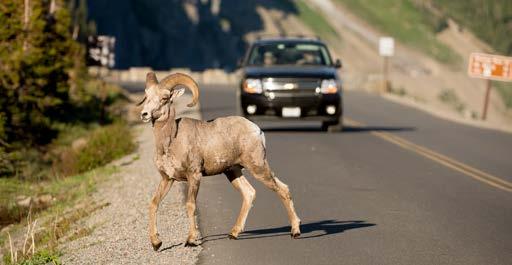
Next, the drive takes you along a zigzag known as the Loop. It takes you higher to a landscape of plunging valleys, waterfalls, and peaks. At 492 feet, Birdwoman Falls cascades down the cliffs, offering a picturesque stop along the road.
This majestic waterfall is best appreciated from viewpoints, where you can savor the sight and sound of cascading waters against the mountainside. The amount of water coming over the falls depends on the snow level received the previous winter and how quickly the melting begins.
Reaching Logan Pass, the highest point on the road at 6,646 feet, opens up a world of alpine beauty. Logan Pass sits on the Continental Divide. Water falling to the west of the divide drains toward the Pacific, and water east of the divide flows toward the Atlantic. Most people opt for a photo standing by the Logan Pass/ Continental Divide sign.
The visitor center provides information on local flora and fauna, while nearby trails, like the Hidden Lake Overlook, invite exploration of the pristine high-altitude environment. Trails
begin and end at the visitor center. You will likely see mountain goats and other animals along the boardwalk trails.
One of the few remaining glaciers visible from the road, the Jackson Glacier Overlook offers a stark reminder of the park’s glacial history. Take in the view and reflect on the natural forces that have shaped this landscape over millennia.
St. Mary Lake is a stunning body of water framed by jagged peaks. It’s an ideal spot for a picnic or a leisurely hike along the shore, providing a perfect ending to your Going-tothe-Sun Road adventure.
Pull over at the Wild Goose Island Overlook for a spectacular view and to capture stunning photos of this mountain gem.
You will see the Triple Divide Peak as you continue toward the St. Mary Visitor Center. It is part of the Continental Divide but has an additional twist. If three drops of rain fell, one on each peak, one would go to the Pacific, one to the Atlantic, and the third would possibly
go north across Canada and into the Arctic Ocean. Your adventure will end on the east side of the park at the St. Mary entrance.
You can easily do the Going-to-the-Sun Road in a day. But if you choose to make it an Extended Weekend Getaway within the park, lodging options range from historic grand hotels and mid-century “motor inns” to rustic cabins. Many Glacier Hotel, Lake McDonald Lodge, and Cedar Creek Lodge are available. Make your reservations well in advance since these hotels book up quickly during peak season.
There are also campgrounds within the park. The park has 13 campgrounds with over 1,000 campsites, but many are first-come, firstserved and can fill up quickly. Campgrounds inside Glacier National Park don’t have water, sewer, or electricity hookups. We stayed outside the park near the West Glacier entrance when we visited.

● Best Time to Visit: The road is typically open from Memorial Day to mid-October. Always check online for current conditions.
● Begin early to avoid traffic and secure parking at popular stops. The early morning light also enhances the beauty of the scenery. If arriving before 6 a.m., you do not need a reservation.
● Bring extra water, snacks, and a first-aid kit, as services are limited along the route.
● Fill your gas tank before beginning your adventure or park and use other transportation.
● Consider using the free shuttle service to reduce driving stress and enjoy the views more fully or take one of the guided tour buses.
● Weather Preparedness: Dress in layers and bring sunscreen to handle high altitudes and changing weather conditions.
● Watch for Bears: With a higher density of grizzly bears than any other national park in the lower 48, Montana’s Glacier National Park is undeniably “bear country.” Staying bear-aware is crucial while hiking and exploring.
● Respect Nature: Follow Leave No Trace principles and observe wildlife from a safe distance.
Road Conditions and Driving Challenges When traveling by private vehicle, please keep the following in mind.
● The roads are well-maintained but narrow: They are generally smooth but have narrow, winding sections with steep drop-offs. Use extreme caution while driving and be aware of potential rockfall and oncoming traffic.
● Rapid Weather Changes: Be prepared for sudden shifts in weather, including possible snow and ice, even in summer.
● Heavy Traffic: Travel early or late in the day to avoid congestion.
● Visibility Issues: Fog, rain, and clouds can reduce visibility—drive cautiously.
● Maintenance Delays: Be aware of potential road work and follow posted instructions.
Learn more at https://www.nps.gov/index.htm
Going-to-the-Sun Road is more than a drive; it’s a gateway to the heart of Glacier National Park’s natural beauty and rich history. Planning and preparedness are key to a memorable trip, whether you explore it in a day or savor it over several days. Embark on your adventure, discover the hidden gems, and become part of the ongoing story of the iconic Going-to-the-Sun road trip.

Western River Expeditions announces limited availability for two of its late summer departures on one of the nation’s most iconic river trips. Departures on Sept. 3 or Sept. 10 offer an unforgettable four-day journey through the heart of Canyonlands National Park along the legendary Cataract Canyon section of the Colorado River.
Cataract Canyon, carved by the confluence of the Green and Colorado Rivers just south of Moab offers a 100-mile-long adventure filled with diverse landscapes, rich history, and exhilarating whitewater rapids. Often hailed as America’s premier river trip, Cataract Canyon combines the thrill of class III-V whitewater with the serenity of breathtaking desert landscapes, ancient ruins, and the timeless flow of the river.
Kam Wixom, Marketing Director for Western River Expeditions, draws inspiration from his personal experiences in Cataract Canyon to capture the essence of this remarkable destination. In his blog, he reflects on the profound connection between the landscape and the human spirit:
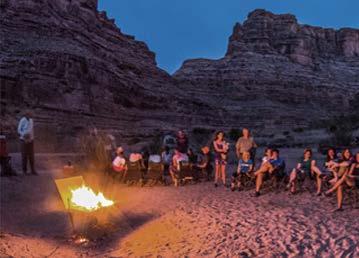
Silent Synchronicity amidst Towering Canyons: “You may find your pulse replicating the rhythms of the landscape!”
Night Sky Meditation under a Blanket of Stars: “Float like an untethered astronaut beneath the cosmos.”
Surrendering Peacefully to the Flow of the River: “On a river, life becomes linear and begins to make sense again.”
Encountering Signs of the Ancient Ones: “A glimpse of ancient history sparks a sense of mystery and wonder.”
Sunrise Meditation at Mesa Arch or Deep in the Canyons: “Experience a sunrise meditation, where the desert awakens in harmony with your spirit.”
Reflection by the River’s Edge: “Is there anything more beautiful than water in the desert?”
To explore more of Kam’s reflections, visit Western River’s blog.
Western River Expeditions offers two distinct ways to experience Cataract Canyon:
1.Cataract Canyon
4-Day Expedition
Immerse yourself in the beau-
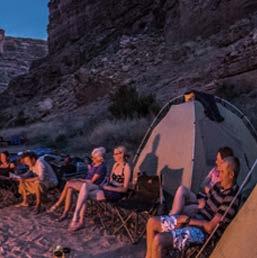
ty and serenity of Canyonlands National Park over four days. Enjoy leisurely rafting, explore hidden waterfalls and ancient ruins, and camp under the stars. The adventure concludes with a scenic flight over Canyonlands National Park.
Price: $1,935 for adults, $1,425 for youth (10-15)
Experience the power of the Colorado River as you navigate through class III-V rapids aboard highspeed, custom rafts. This two-day adventure offered
May through July, is perfect for those seeking maximum thrills in minimal time.
Price: $965 per person (Adults and Youth 12+)
Don’t miss a chance to embark on a oncein-a-lifetime adventure this September. To book your trip, request a catalog, or for any inquiries, please call toll-free at 866.904.1160 (Local: 801.942.6669) or visit the
website at www.westernriver. com.
Western River Expeditions, operating from March through October, is the leading provider of professionally guided rafting trips in Utah, Idaho, and Arizona. As the largest licensed outfitter in the Grand Canyon and the primary tour provider in Moab, UT, through its division Moab Adventure Center, the company has been a trailblazer in adventure travel since 1961. Western River Expeditions has received the “Best of State” award in Utah for 20 consecutive years (2004-2023).
More on Utah >HERE



Wendy Lee Travel Writer
If you’re planning a vacation that will include a few generations of the family, look no further than the small city of Spokane in Eastern Washington. While offering all the amenities of a big city including an international airport, full service hotels, and excellent dining, Spokane is far easier to navigate, with far less traffic, and more affordable to boot.
Late spring through early fall are ideal times to visit since the weather is welcoming and the city is offering a nice selection of events and festivals.
Riverfront Park
Having a river running through a city isn’t unusual, but the city of Spokane’s river features the largest urban waterfall in the United States. Wisely, the city has chosen to make their river and waterfall a centerpiece attraction for both residents and visitors. Lush green lawns,

winding pathways, playgrounds, and fountains line both sides of this 100 acre park.
Originally created in 1970 for the Expo ‘74 (a world’s fair held May through November in 1974), the park underwent a

massive rehabilitation project starting in 2016. Today you’ll find spaces and attractions for all ages and abilities. There’s the 1909 Looff Carrousel, SkyRide over the falls, the city’s first all-inclusive playground, and of course, the Garbage Goat. Crafted from copper and brass with a vacuum system that “eats” garbage, the goat is a fun way to encourage park visitors to properly dispose of trash instead of littering.
The park is per-
fect for a quick stroll or a full day destination. Throughout the summer there’s a full lineup of events including yoga, pilates, concerts, movies, and for the younger visitors, storytime at the carrousel.
During the hottest months of the year there’s nothing better than cooling down on a rafting trip down the Spokane River. With rapids typically in Class I and II, this is really more of a floating trip making it perfect for all ages (minimum age is 5). Wiley E. Waters offers 2 to 3 hour trips April through July that include an expert guide and plenty of cold beverages.
Running alongside or near the
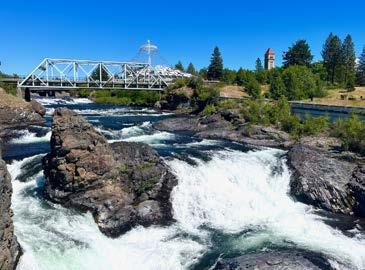
Spokane River–and for a brief stretch, through Riverfront Park–is the Spokane River Centennial Trail. This fully paved trail begins in Nine Mile Falls, Washington, and winds its way for almost forty miles to the Washington/Idaho state line. After crossing into Idaho it becomes the North Idaho Centennial Trail where it contin-
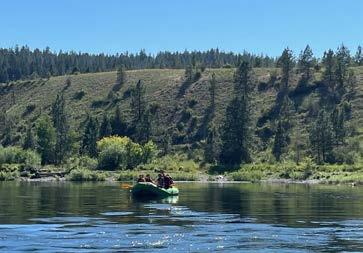
ues for twenty-four miles. No motorized vehicles are allowed on the trail making it perfect for walkers, runners, and cyclists. Children in strollers and dogs are also welcome. Access to the trail and parking can be found at about twenty locations along the route.
If your group includes young kids then a visit to the Mobius Discovery Center is in order. The mission of this museum is to create experiences to inspire visitors. With a clear focus on science, there’s an array of hands-on activities to learn about bee-keeping, building bridges, bike safety, and much more. There’s a line-up of educational events throughout the year. The Center also features planetarium shows, but this does require an additional ticket and show times are limited.
The whole family is welcome at the Northwest Museum of Arts and Culture, more commonly referred to as MAC. With a line-up of rotating exhibits there is something for everyone. Current exhibits include Driving the American Dream; 1970’s Car Design, displaying an impressive collection of classic cars. Another exhibit, It Happened Here: Expo ‘74 Fifty Years Later, recounts the highs and lows of this six month world’s fair.

the time. In the early 2000’s it underwent a major renovation with high priority being placed on preservation. The rooms have been fully modernized, but with furnishings that suggest the early 20th century.
Spokane may be a small city, but the dining scene punches above its weight. There are some seriously good restaurants and bars in town.
Admission to the MAC includes access to the historic Campbell House, a 125 home built in the English Tudor Revival style. This home gives a glimpse into the life of Spokane’s wealthy residents in the late nineteenth century.
If you want to be in the heart of the city and can splurge a bit, a stay at the Davenport Grand Hotel or the Historic Davenport Hotel are in order. The first is part of Marriott’s Autograph Collection and features large rooms with contemporary decor and in many cases a view of Riverfront Park. Located across the street from the First Interstate Center for the Arts, it’s ideal for a pre or post theater meal or drink.

Cocktail lovers should head to Dry Fly Distilling, an establishment that sources all of its grain from family owned farms within 30 miles of the distillery. Their whiskies, vodka, and gin are all worth a try by themselves or mixed into a cocktail. More recently they’ve made a name selling canned cocktails which are now sold throughout Washington and many other states.
For brunch head to the perfectly named House of Brunch, where you can opt to stay on your healthy diet or splurge with some indulgent sweets. For a decadent hot beverage try the Trippy Unicorn made with organic mushroom powder, white coffee, oatmilk, and topped with 24k gold flakes.
The Historic Davenport–also part of Marriott’s Autograph Collection–opened in 1914 and was considered one of the most modern hotels of
Highly rated dinner spots include Zona Blanca Ceviche Bar and Ruins. The first specializes in seafood dishes from Baja Mexico and the second offers a rotating seasonal menu influenced by international cuisines.


Norman Reed Managing Editor

If you’ve ever dreamed of stepping into the pages of a Wild West adventure, then Wyoming is where you need to be. I recently spent a long weekend exploring this incredible state, and it was nothing short of breathtaking. From the cowboy charm of Cody to the jaw-dropping beauty of Yellowstone, this trip left me with memories that will last a lifetime— and I’m already planning my next visit. Here’s how you can experience it too.
The Chief Joseph Scenic Byway is a 46-mile journey through some of the most breathtaking landscapes in the American West. Named after the legendary Nez Perce leader, Chief Joseph, this byway offers not just a drive but a passage through history, geology, and nature that leaves an indelible mark on all who experience it.
The Chief Joseph Scenic Byway follows the route taken by Chief Joseph and the Nez Perce tribe during their epic flight from U.S. Army forces
in 1877. As you travel this route, it’s easy to imagine the challenges faced by the Nez Perce as they crossed these rugged mountains. Historical markers along the way provide insights into this poignant chapter of American history, making the byway not just a visual experience but an educational one as well.
Most travelers begin their journey in Cody, Wyoming, a town steeped in the legacy of Buffalo Bill. Before embarking on the byway, take time to explore Cody’s rich history at the Buffalo Bill Center of the West, where you can learn about the area’s wildlife, art, and Native American culture.
Leaving Cody, the byway quickly ascends into the Absaroka Mountains, offering sweeping views of the surrounding wilderness. The drive climbs to over 8,000 feet, with stunning vistas of jagged peaks, deep canyons, and dense forests. Be sure to stop at the Dead Indian Summit Over-

look, where you can gaze out over the Clarks Fork River and the expansive valley below. This vantage point is not only a photographer’s dream but also a place to reflect on the history that unfolded here.
The byway winds through the Shoshone National Forest, one of the largest national forests in the U.S., and home to an array of wildlife. Keep your eyes peeled for elk, deer, bighorn sheep, and even the occasional bear. The area’s pristine rivers and streams are ideal for fishing enthusiasts, with opportunities to catch trout in the clear mountain waters.
Beyond its historical significance, the Chief Joseph Scenic Byway is also a geological marvel. The route takes you through Sunlight Basin, a region formed by ancient volcanic activity. The landscape here is a mix of striking rock formations, lush meadows, and dense forests.
The Sunlight Creek Bridge, one of Wyoming’s highest, offers an impressive view of the deep canyon below and is a must-stop for anyone seeking a truly dramatic photograph.
For many, the Chief Joseph Scenic Byway is part of a larger adventure to Yellowstone National Park. The byway connects with the Beartooth Highway, which then leads directly into Yellowstone’s northeast entrance. This route is considered one of the most scenic drives in America, combining the beauty of the Chief Joseph Scenic Byway with the grandeur of Yellowstone.
The Chief Joseph Scenic Byway is typically open from late spring through fall, but weather conditions can vary, especially at higher elevations. Travelers are advised to check road conditions before setting out and to be prepared for sudden changes in weather. The entire drive can be done in a few hours, but plan to spend a long weekend to appreciate the sights and sounds along the way. Whether you’re a history buff, a nature lover, or simply someone in search of tranquility and beauty, the Chief Joseph Scenic Byway offers a unique and unforgettable experience. More on Wyoming





The James B. Beam Distilling Co. (aka, the Beam Distillery!) is celebrating their 90th anniversary of the Clermont campus. This marks a major milestone and momentous occasion for the First Family of Bourbon who have been in the whiskey-making business for nearly 230 years.
In 2022, The James B. Beam Distilling Co. underwent a multi-million-dollar campus renovation including a revamp of the American Outpost, opening of The Fred B. Noe Distillery, and adding The Kitchen Table restaurant, further establishing the distillery as a must-visit tourism destination. Since then, daily visits have increased by 60%
Expanded programming offers an inside look into the world of whiskey making, Beam family history, and 8ight generations of craftsmanship. For the first time, consumers now have access to the state-of-the-art Fred B. Noe
Distillery with a limited series of “Behind The Beam” events where guests can enjoy a personalized tour and tasting led by one of our Master Distillers.
Get a glimpse behind the scenes at the production methods that helped the First Family of Bourbon build the world’s favorite Bourbon and an innovative portfolio of small-batch whiskeys. Following the tour, guests are treated to some of Beam’s finest whiskey and a few of the most sought-after new releases paired with a Kentucky-inspired lunch at The Kitchen Table
Bourbon lovers can join Fred and Freddie Noe on an experience through the historic warehouses and learn the secrets of how time, temperature and wood impact the bourbon.
• Little Book® + Country Ham
Follow through the process of blending a new batch of Little Book and enjoy a tasting against other traditional bourbons.
• Cocktails
With so much mixology experience, what are the favorite cocktails of the Master Distillers of the First Family of Bourbon? An immersive mixology experience in which you’ll explore which cocktails pair best with Beam Distilling brands.
• 8 Generations Tasting
Taste through 229 years of whiskey making and discover the unique fingerprint each generation has left on this iconic spirit.
• Knob Creek Tasting
Featuring Knob Creek’s lauded small-batch bourbons and rye whiskeys.
• Sept.12 - Little Book®
• Oct. 17 - Beam Family
• Nov.14 - Distillers’ Share™
• Dec. 12 - Holiday Edition
Visit beamdistilling.com for more information and and to purchase tickets.
More on Kentucky >HERE


By Kandy Derdent Managing Editor of Seasonal Eatings
Bristol, Tennessee/Virginia is confusing at first until you realize the town is in both states, and yet still operates as a single city. State Street is so named because it is quite literally, the state line between the two states. Markers are embedded in the pavement of this street in the downtown area. This gives pedestrians ample opportunity to snap a photo of being in two places at one time.
One of the places you need to see is the Bristol Motor Speedway, also known as The Last Great Colosseum. At first, it seems small, especially when compared to some of the newer racetracks used by Nascar. However, this is a good thing for spectators. Unlike the larger stadiums, fans can see all the action on the track all the time.
Bristol is not just for racing enthusiasts. History buffs will be interested in the musical heritage associated with this town. Rich in History. Rich in Music.
They are one and the same for Bristol which is the birthplace of country music. Check out birthplaceofcountrymusic. org/museum for hours of operation. My favorite exhibit was about Tennessee Ernie Ford who was born in Bristol. His home is part of the walking tour.

Photos by David Derden
Even though we were only there a short time, I managed to find a couple of hours to stroll the main street and do a bit of souvenir shopping. I found all the typical tourist shops you would expect in

a small town. Of particular interest was Southern Churn, an ice cream and candy shop. One of their many specialties is homemade fudge available in numerous flavors - including peach! It was one flavor I had never seen before, much less taste. We tried to ration is so it could be enjoyed for several days. However, it was fudge! Now I don’t know about you, but in our family, rationing and fudge just don’t belong in the same sentence. For more information check out thesouthernchurn.com .
Likewise, the Blackbird Bakery is where we tried to make our selections last. The showcases were bulging with the largest

assortment of pastries I have ever seen in one place. As a result we were able to sample a doughnut, brownie and a lemon blueberry cheesecake bar. The location is not on the main business street, but is very close by on a side street. BlackbirdBakeryBristol.com
One of my favorite stops was Cranberry Lane, a gift shop specializing in pleasures and treasures for your home. I found all sorts of lovely items which would make

excellent gifts. Alas, our car was just not large enough to take home the many delightful accents I found to enhance my
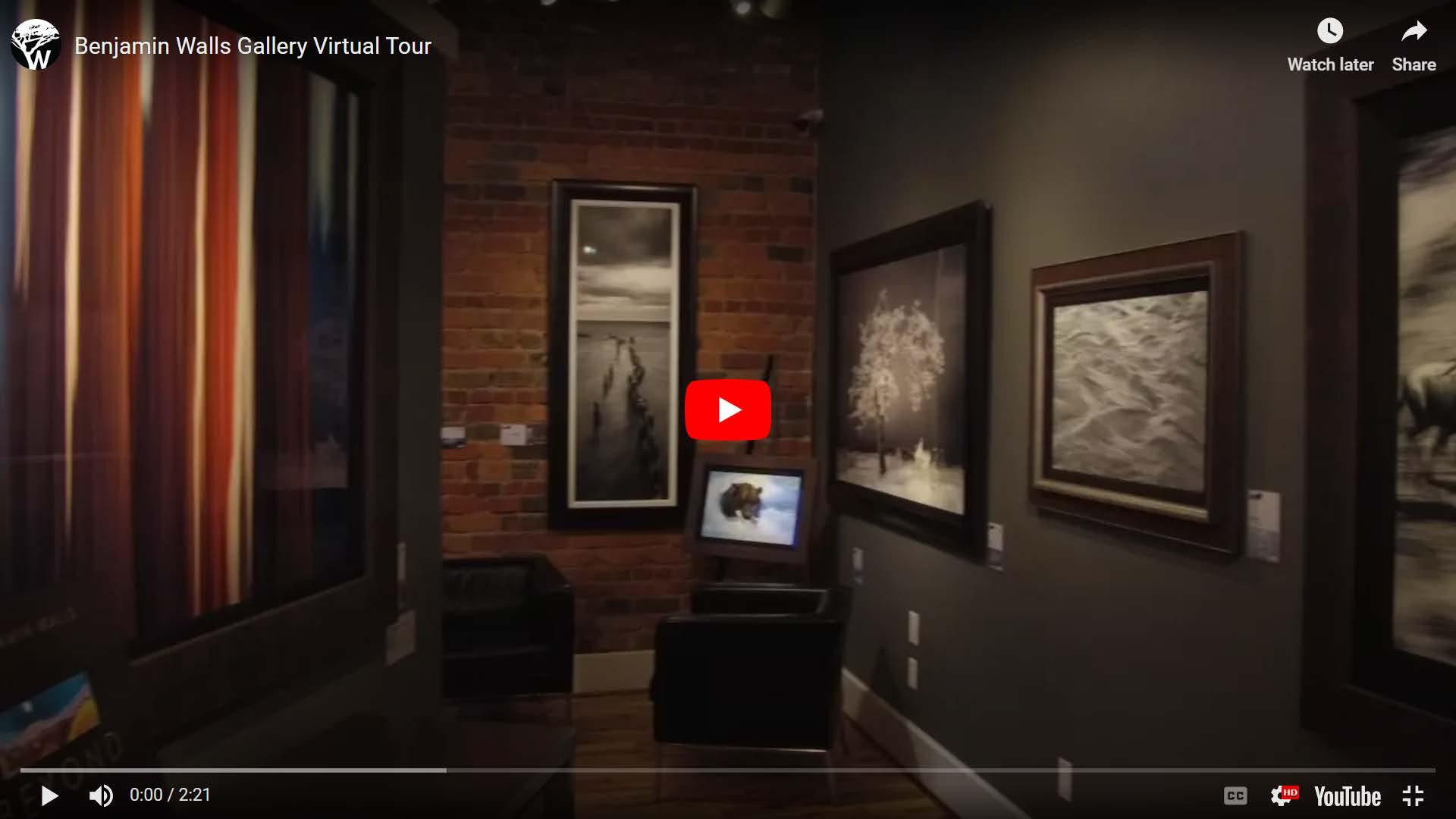
décor. I found candles, wall art, and even a year-round Christmas section. I finally selected some unique coasters as a reminder of our time spent in this area. See more at cranberrylanehome.com .
While strolling along with no particular agenda in mind, I noticed an art gallery. I don’t know why I was surprised by the display, but I was. The photography on exhibit was extraordinary! Even though I didn’t plan to go inside, instinct drew me in to see and learn more. Soon I was experiencing photography like never before.
At first, it was impossible not to notice the oversized canvasses. Then, once I stepped back and begin to enjoy the encompassing beauty, I begin to notice smaller pieces appropriately positioned for the best viewing.
It didn’t take long to zero in on a particularly spectacular image. Lela Strobell, the Fine Art Consultant working in the gallery explained the circumstances involved in getting the shot. “The story regarding the Oxbow Landing image is not uncommon for Benjamin. He will wait out storms, heat, brace himself against the elements, return year after year after year to capture the image he is after! Specifically with Oxbow Landing, the dark storm clouds almost dominate the background of the image. After a long, cold day, he focused his lens on the geese landing in the water. All of a sudden, the clouds above opened, revealing a magnificent spotlight on the golden Aspens along the shore. It has become a collector favorite!”

a five-time Smithsonian Exhibitor and winner of several international awards. Check out more of his story at www. BenjaminWalls.com.
My walkabout ended with a visit to the local farmer’s market where I met some of the friendliest people in the area. Alas, just like the giftshop, I had no room in our vehicle for the fresh yumminess they offered.
fast the next morning. We had a hearty breakfast which is best described as scrumptious! I opted for a breakfast sandwich so I could get the home fries again but everyone else ordered French toast. It was a challenge to eat it all, but we gave it our best shot. Yum!
The historic building was once an Old South/Battery location and has since been completely restored.
In the early years especially, Benjamin’s dedication to his craft was impressive. Perhaps the best example of this was evidenced when he rationed food to save money for buying more film. Was it worth it? You decide. He is now
However, after all the walking and exploring, I was ready for dinner. We ate at Southern Craft BBQ, an excellent restaurant located right beside our hotel. They had a wide variety of hot sandwiches served with homemade onion rings or home fries. They were so good, we returned for break-
Our hotel was named Sessions because it was a former recording studio for the above-mentioned country music. Each room is furnished with the music recording theme and equipped with a record player and an assortment of albums. There is never the need to worry about bothering the neighboring room with your music. The soundproof walls from bygone recording days are still in place. So feel free to sing along if you wish. More on Virginia >HERE

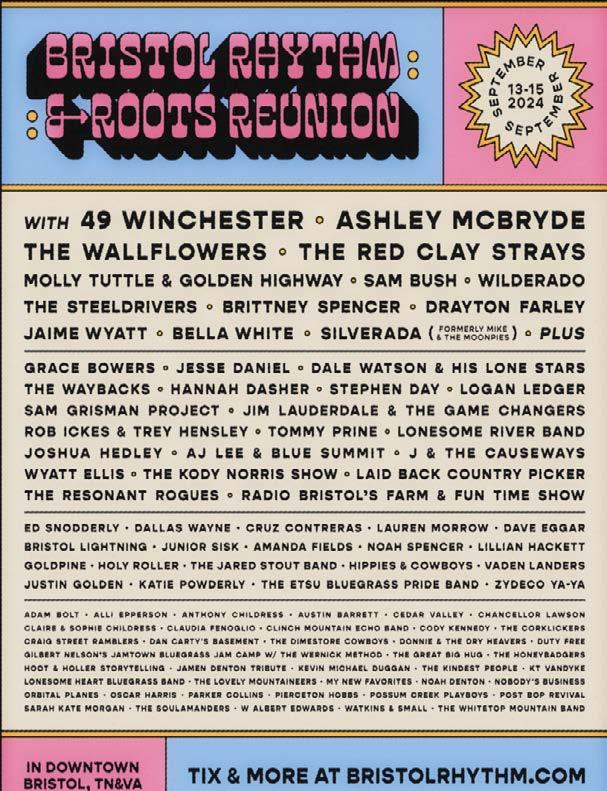
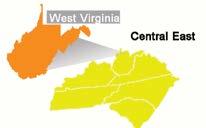
By Kathy Barnett Editor-In_Chief

Embark on a journey through the heart of West Virginia, a state rich in natural beauty, history, and adventure. This scenic loop drive will take you through picturesque mountains, rolling valleys, and charming towns, offering the very best of the Mountain State. Perfect for a weekend getaway, this trip combines outdoor exploration, cultural experiences, and unforgettable vistas.
Begin your adventure in Morgantown, the home of West Virginia University. Morgantown is a lively college town, bustling with energy and filled with unique restaurants, shops, and cultural attractions. Before hitting the road, take a stroll along the Monongahela River at the Hazel Ruby McQuain Park or visit the WVU Core Arboretum for a peaceful walk through native trees and wildflowers.
For history buffs, the Morgantown History Museum offers a glimpse into the region’s past, while sports enthusiasts might enjoy a visit to the WVU Coliseum, where the Mountaineers play. Once you’re ready to depart, head southeast on US-119 towards the majestic Monongahela National Forest.
As you leave Morgantown behind, the landscape quickly transforms into the stunning,-

forested expanse of the Monongahela National Forest. This 900,000-acre region is a haven for outdoor enthusiasts. Whether you’re interested in hiking, camping, or skiing, Monongahela has something to offer year-round.
Consider stopping at the Seneca Rocks, one of the most iconic landmarks in the area. This towering rock formation is a favorite among climbers, but even if you’re not up for scaling the cliffs, the views from the base are breathtaking. For a more leisurely experience, take a scenic drive through the forest, where every twist and turn reveals a new vista.
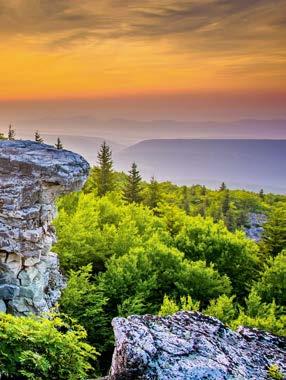
If time permits, explore the Spruce Knob, the highest peak in West Virginia. At 4,863 feet, the summit provides panoramic views of the surrounding mountains and valleys. After soaking in the beauty of Monongahela, continue your journey westward towards the state capital.
Arriving in Charleston, you’ll be greeted by the impressive sight of the gold-domed Capitol Building. This historic structure is a must-see, and guided tours offer insight into the state’s political history. Charleston also boasts a vibrant cultural scene, with attractions like the Clay Center for the Arts and Sciences and the
West Virginia State Museum.
For a more leisurely experience, take a walk along the Kanawha River at Haddad Riverfront Park, where you can enjoy stunning views of the city skyline. Charleston’s downtown area is filled with local restaurants, shops, and galleries, making it the perfect place to relax and unwind before continuing your loop.
Before completing your journey, take a detour to the charming town of Lewisburg. Known for its historic downtown and vibrant arts scene, Lewisburg is also home to the Lost World Caverns. Here, you can descend 120 feet into the earth to explore a hidden underground world of stalactites, stalagmites, and other fascinating rock formations. This natural wonder is a mustsee and offers a unique adventure for travelers of all ages.
After exploring the caverns, continue your drive northeast on I-79 to complete your loop back to Morgantown. As you wind through the rolling hills and valleys of West Virginia, take a moment to reflect on the diverse experiences this scenic drive has offered.
From the lively streets of Morgantown to the serene beauty of the Monongahela National Forest, the historic charm of Charleston, and the underground wonders of Lewisburg, this West Virginia road trip showcases the very best of the Mountain State. Whether you’re seeking outdoor adventure, cultural experiences, or simply a peaceful escape, this scenic loop is the perfect weekend getaway.
More on West Virginia >HERE


Renée S. Gordon
Travel and History Writer
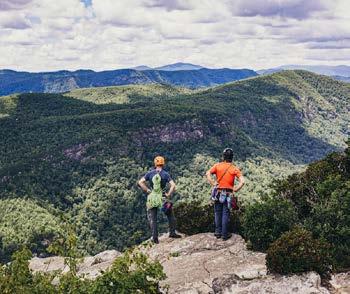
The Blue Ridge Parkway, recognized as “one of America’s Favorite Drives,” was constructed by President Roosevelt’s New Deal Civilian Conservation Corps and Italian and Spanish stone masons in 1930. The Parkway runs along the rim of the Blue Ridge Mountains for 469-miles scenic miles with panoramic views. The drive was created to connect Virginia’s Shenandoah National Park with North Carolina’s Great Smoky Mountains National Park of North Carolina. Mileposts are used to mark distances on the trail. Beginning with zero in the Shenandoah Valley and increasing in number as you drive southward.
The Parkway traverses 29 counties and features 26 tunnels, 176 bridges and six viaducts. Bluff Mountain Tunnel, located at milepost 53.1, is the only tunnel in the Virginia section of the Parkway. Winter weather may cause closings of portions of the road so drivers should check for alerts prior to any trip. The National Park Service operates the Blue Ridge Parkway and it is the most visited unit in the National Park System. www.nps.gov
The Blue Ridge Mountain and foothills were the homeland of the Cherokee, Monacan, Saponi and Tutelo indigenous tribes. It is the Cherokee of North Carolina who first named the mountains Shaconage, “land of the Blue Mist,” denoting the blue haze that cloaks parts of the mountain. Additional names along the Parkway reflect
the Indian presence. The Peaks of Otter Visitor Center Museum, at milepost 85.9, interprets the archeological finds in the area including tools. The entrance to the Cherokee Indian Reservation is located at milepost 457.7 and at Lickstone Parking Overlook, milepost 458.9, there is an informational plaque.
European settlers entered the area to establish homesteads bringing with them their unique arts and culture and the Parkway showcases a number of pioneer buildings in their original settings. The first of these clusters is found at MP 5.8 at the Humpback Rocks Visitor Center and Mountain Farm. An easy self-guided path takes visitors to a group of 19th-century farm structures. The center offers seasonal history programs.
MP 85.9, the Peaks of Otter, offers a loop trail to a farm owned by the Johnson Family for generations. Polly Woods Ordinary, believed to be the oldest edifice on the Parkway is also situated here. Constructed of logs in the early 1800s it
functioned as an inn, run by the widow Polly, from the 1830s to the 1850s. She was licensed to run an ordinary, an inn that catered to the ordinary needs of travelers. Eventually it closed because Polly’s retired.
The Claudill Cabin (MP 241) is considered one of the finest pioneer cabins along the Parkway. The cabin is isolated and is accessed by a 9.4mile trail. The Jesse Brown Farmstead (MP 272.5) is a complex inclusive of a cabin, spring house and Cool Springs Baptist Church. Jesse Brown was a preacher who rode the circuit. Services were held outdoors and the church was only used during inclement weather. The structures, believed to have been built prior to the 1860s, have been relocated to land he owned.
The region’s pioneers engaged in industries remnants of which remain.
Yankee Horse Ridge parking area (MP 34.4) has a portion of reconstructed narrow-gauge railroad track, known as the Irish Creek Railway and a display on logging. MP 63.6, the James River visitor center has a restored lock dating from the mid-19th century.

There are several stories regarding the naming of the Peaks of Otter at MP 86. My favorite is that they were named after a form of the Cherokee name, ”Otari,” meaning high places. Native Americans visited this area for more than 8,000 years and considered it a place of power. Today it continues to be a place of stunning beauty. Surrounding Abbott Lake are the Peaks, three mountain peaks, Sharp Top, Flat Top and Harkening Hill. Thomas Jefferson wrote of the Peaks of Otter, believing they were taller than they were. Virginia was so in awe of the Peaks that they sent stones to be used in the construction of the Washington Monument. Visitors can contemplate the view from the Otter Lodge and restaurant.

Mabry Mill Trail (MP 176.2) is a series of structures including Matthew’s Cabin a blacksmith’s shop, whiskey still, wheelwright’s shop and the Mabry Mill. The Mill was constructed by Mr. Mabry circa 1903-1914 and functioned from 1905-1935. The water powered mill is the most photographed edifice on the Parkway, hosting more than 100,000 visitors annually.
Nine miles from the Peaks of Otter, just off. the Parkway, is the town of Bedford, Virginia, home to the astonishing National D-Day Memorial. The quiet town of Bedford had the highest per capita losses in the nation on D-Day. The memorial’s invasion tableau is particularly powerful. A self-guided tour takes you through the planning stages, through the battle and ends at a victory arch.
Back on the Parkway at MP 407.6 there is a trail to the top of Mt. Pisgah. The hike is strenuous up the 5,721-ft. peak but the views are reward-

ing. The Pisgah Inn is located at MP 408.7. The only inn and restaurant on the Parkway in Virginia. The inn is situated at 5,000-ft. and while dining you can bask in the view from the restaurant’s big windows.
The 1,234-ft. Linn Cove Viaduct in North Carolina was completed in 1987. It clings to Grandfather Mountain and is considered an architectural marvel at MP 304. This concrete s-shaped bridge is comprised of 153, 50-ton, sections.
There are entrances and exits to the interesting sites adjacent to the Parkway. Downtown Roanoke is a short drive from MP 120 and at the other end Asheville exits (MP 382, 393).
North Carolina is a perfect place to purchase
traditional, local, mountain handcrafts. Three places on the Parkway are Northwest Trading Post MP 258.6, Parkway Craft Center MP 294.1 and the Folk Art Center MP 382. #Visitnorthcarolina.
The Blue Ridge Parkway is considered one of the bucket list road trips in the United States with world class scenic panoramas of mountain vistas. If you are planning a trip all pertinent information is available at Blueridgeparkway. org
More on Virginia >HERE
More on North Carolina >HERE
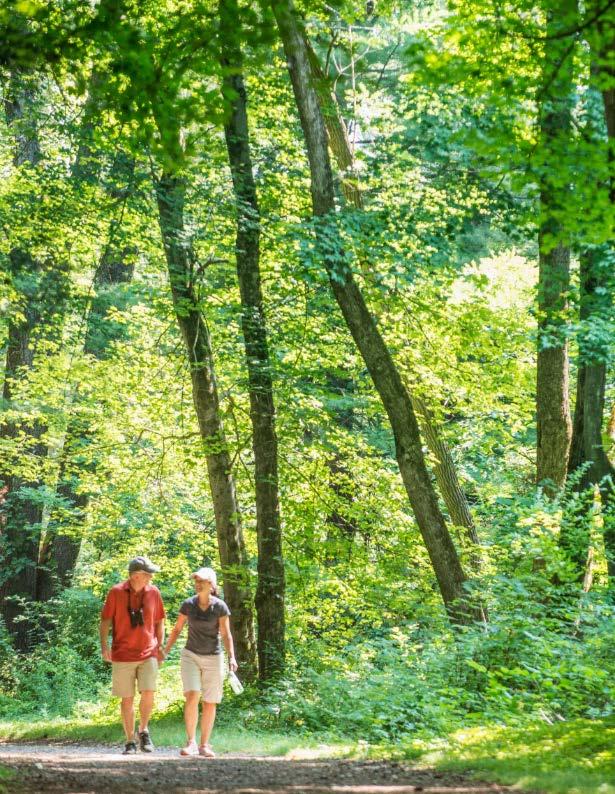



By Rebecca Embry Staff Journalist
New England, with its charming small towns, historic landmarks, and breathtaking scenery, is an ideal destination for an extended weekend road trip. Whether you’re seeking the vibrant colors of fall, the quaint allure of coastal villages, or the peaceful serenity of mountain landscapes, this region has something for everyone. Here’s a suggested route to experience the best of New England in just a few days.
Start your adventure in Boston, Massachusetts, the cradle of American history. Before hitting the road, explore some of Boston’s historic sites, such as the Freedom Trail, the Boston Common, and Quincy Market. Grab a coffee and a fresh pastry from a local bakery, then head north on I-95 towards the charming coastal city of Portland, Maine.
As you drive, enjoy the scenic views of the Atlantic coastline. Upon arrival in Portland, take time to explore the Old Port district with its cobblestone streets, boutique shops, and waterfront restaurants. For lunch, indulge in a classic lobster roll at one of the many seafood shacks. In the afternoon, visit the Portland Head Light, one of the most photographed lighthouses in the country, located in Cape Elizabeth. End your day with a craft beer tasting at one of Portland’s renowned breweries before settling into a cozy

On the second day, leave the coast behind and journey west towards the majestic White Mountains in New Hampshire. Take Route 302 for a scenic drive through quaint New England towns and beautiful countryside.
As you approach the White Mountains, consider stopping at North Conway, a charming town known for its shopping outlets and proximity to outdoor activities. If you’re up for an adventure, take the Mount Washington Auto Road to the summit of the Northeast’s highest peak. The panoramic views are nothing short of spectacular.

After exploring the mountain trails and waterfalls in the area, head to a cozy cabin or a charming bed-and-breakfast for a night surrounded by nature.
(2.5 hours, 120 miles)
On the final leg of your trip, drive west through the lush landscapes of New Hampshire and into Vermont, where rolling hills and picturesque villages await. Your destination is Stowe, a quintessential New England town known for its covered bridges, quaint downtown, and stunning mountain views.
Once in Stowe, take a leisurely walk through the village, visit local artisan shops, and enjoy a farm-to-table lunch at one of the town’s many excellent eateries. For outdoor enthusiasts, a hike or bike ride on the Stowe Recreation Path offers beautiful
views of Mount Mansfield and the surrounding countryside. In the evening, relax with a visit to a local cider house or brewery.
(3.5 hours, 215 miles)
On your final day, take a short drive to Burlington, Vermont, located on the shores of Lake Champlain. Start your day with a stroll along the Burlington Waterfront, where you can take in views of the lake and the Adirondack Mountains. Explore Church Street Marketplace, a pedestrian-only area filled with shops, cafes, and street performers.
After enjoying a lakeside lunch, begin your journey back to Boston. The drive takes about 3.5 hours,
giving you time to reflect on the diverse landscapes and charming towns you’ve encountered along the way.
This New England road trip offers a perfect blend of coastal charm, mountain majesty, and small-town allure, making it an ideal extended weekend getaway. With each stop offering its own unique experiences, you’ll return home with memories of scenic drives, delicious food, and a newfound appreciation for the beauty of New England.



By Michael C. Upton
Fourteen states have access to one of America’s Top 10 Most Popular Road Trips, the Lincoln Highway. Pennsylvania claims a key stop on this route—Gettysburg—and provides plenty of other highlights along the road.
When the United States was a land of dusty, impassable roads cross-country travel was more a fantasy than a reality. Enter Carl Fisher, the visionary behind the Indianapolis Motor Speedway who dreamed of a transcontinental highway that would link the nation from coast to coast. His ambitious project, the Lincoln Highway, was—and still is—a patriotic tribute stretching from New York City to San Francisco.
By 1921, the highway had evolved into a symbol of progress, sparking the federal government’s investment in road infrastructure. Though it eventually merged into the U.S. highway system, the Lincoln Highway remained a cultural icon, immortalized by Boy Scouts who marked
its route with Lincoln busts. Today, the Lincoln Highway is a testament to America’s pioneering spirit, with its legacy preserved by enthusiasts who continue to celebrate this historic road. The Pennsylvania section of the route stretches 292 miles from Morrisville on the Delaware River to Glasgow before entering Ohio.
If driving along this route is a history-based endeavor, plan to spend plenty of time in Gettysburg. The David Wills House, on Lincoln Square, is where Abraham Lincoln spent the night before delivering the Gettysburg Address. Part of the Seminary Ridge Museum is housed in one of the largest field hospitals during the Civil War and today features knowledgeable guides and even an escape room. Both stops, and many more, are located along Route 30, a.k.a. Lincoln Highway.
In the surrounding countryside, the route travels through some of the nation’s most fertile orchards. The Historic Round Barn in Biglerville is one of only a few of its architectural design still standing in the United States. It serves as a market today selling local produce (especially apples), goods, and souvenirs. Thirsty Farmer Brew Works is located
across the street. The interactive Adams County Crop Hop guides visitors traveling Lincoln Highway to a handful of markets, boutique stores, and orchards to acquire “checkins” for discounts and prizes.
Lincoln Highway enters Fulton County east of McConnellsburg in a valley known for its bucolic landscape. Be on the lookout for barn quilts— large, colorful, painted wood or metal squares hung on the outside of buildings to resemble quilt blocks—as the area holds many of the more than 200 barn quilts comprising the Frontier Barn Quilt trail. Other highlights along this section include Cowans Gap State Park and Burnt Cabins Grist Mill.
As the route climbs through the Laurel Highlands the views become increasingly spectacular. But these hills became part of the national interest for a far more somber reality. One of four aircraft hijacked by terrorists on September 11, 2001, was downed in a field only a few miles from the Lincoln Highway. The Flight 93 National Memorial is a five-minute detour, but a must visit—plan to spend several hours here. Afterwards, a stop


at Forbes Trail Brewing can help elevate the mood and the brewery always has a beer on tap with proceeds going toward memorial maintenance.
In Westmoreland County, Route 30 passes through the picturesque borough of Ligonier. Side stops include downtown shops, the Compass Inn Museum, and a reconstructed British fort taking travelers back to the 18th century. Heading west toward La-
trobe—the home of Mr. Rogers and the banana split—drivers can stop in at the Lincoln Highway Experience, a foundation and museum dedicated to the Lincoln Highway in Pennsylvania.
Over the years the Lincoln Highway endured route changes, with the most significant variations coming in 1928. This was also the year Boys Scouts placed markers along the route on the average of one per mile. In Pennsylvania, many of the changes appeared in and around Philadelphia,
with Center City detoured after the first round of alterations. Between Lancaster and York Counties a new bridge over the Susquehanna River only moved the route slightly, but as Route 30 became a larger east/west road for state travel, small towns—especially in the western part of the state—veered off 30’s new design.
The greatest change occurred in 1928 when the Lincoln Highway left Pittsburgh on a more southern route. This deviation allowed the famed road to enter West Virginia. Whether you leave the state near Hookstown or across the Ohio River in Glasgow, there is plenty to recollect on this memorial highway.
More on Pennsylvania >HERE

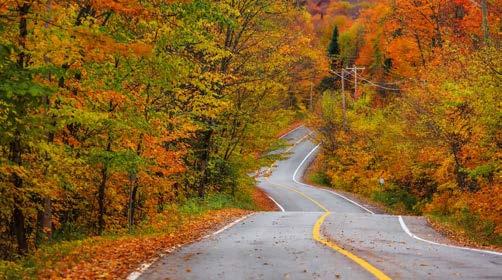

By Norman Reed Managing Editor
Running north to south through the heart of Vermont, the Scenic Route 100 Byway (SR 100) offers one of the most picturesque drives in New England. This iconic stretch of road spans nearly the entire length of the state, meandering alongside the eastern border of the Green Mountain National Forest and connecting a string of charming towns and renowned ski resorts. Known affectionately as the “Skiers Highway,” SR 100 is a favorite among winter sports enthusiasts. However, its allure extends far beyond the snow-covered months.
As you embark on this scenic drive, you’ll be immersed in Vermont’s rural charm. The road winds through quintessential New England towns, each with its unique character, historic landmarks, and welcoming locals. Quaint general stores, cozy inns, and artisan shops dot the route, providing perfect opportunities to stop, explore, and savor the local flavor.
While SR 100 is a year-round destination, fall is when the byway truly shines. From late September to mid-October, the landscape transforms into a vibrant tapestry of red, orange, and gold. The Green Mountains, flanking the road, become a breathtaking backdrop for leaf-peeping adventures. The crisp autumn air, coupled with the stunning foliage, makes this stretch of road
a bucket-list experience for travelers seeking nature’s beauty at its peak.
Come winter, SR 100 becomes the gateway to some of Vermont’s premier ski resorts, including Stowe, Killington, and Okemo. Whether you’re an avid skier or just looking to enjoy a snowy retreat, the byway offers easy access to world-class slopes, cozy lodges, and après-ski activities. The snow-covered landscape provides a serene and magical setting for winter exploration.
Beyond skiing and fall foliage, SR 100 is a hub for outdoor activities throughout the year. Hiking, biking, and paddling opportunities abound in the surrounding Green Mountain National Forest. Whether you’re trekking through lush summer greenery or enjoying the peacefulness of a springtime drive, the byway is a nature lover’s paradise.
SR 100 is ideal for a leisurely road trip, allowing you to take in the sights and sounds of Vermont at your own pace. Consider extending your stay in one of the charming towns along the way, such as Woodstock, Waterbury, or Ludlow. Whether you’re planning a fall foliage tour, a winter ski getaway, or a summer adventure, Scenic Route 100 Byway offers a quintessential Vermont experience that will leave you captivated and longing to return.
For a truly immersive experience, consider spending a few days along the byway to explore the natural beauty, outdoor activities, and unique charm of Vermont’s countryside. Whether you’re a skier, a leaf-peeper, or a nature enthusiast, SR 100 offers an unforgettable journey through one of the most scenic regions of the state. More on Vermont >HERE

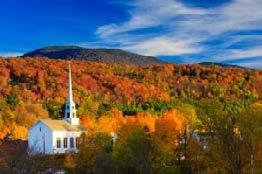

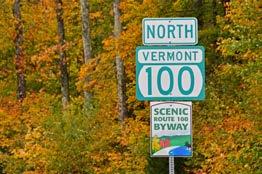



In the heart of Indiana, Anderson offers a perfect blend of smalltown charm and vibrant events that make it a must-visit destination this September. Whether you’re a history buff, a car enthusiast, or simply looking for a fun weekend getaway, Anderson has something for everyone.
Planning a girlfriend getaway road trip? You can definately “shop ‘til you drop” here. Madison County as a whole has several quaint specialty shops to discover. Personal favorites are Simple Goodness Soaps, Carol’s Legacy Crystal, The McCurry’Osity Shop, Magication Station and the B’Dazzled Boutique
For more places to go, things to do and people to see, visit https://visitandersonmadisoncounty.com/calen-
dar-of-events/ Here a just a few examples:
PENDLETON - Fall Creek Heritage Fair is Sept. 6-7 from 10 a.m. to 6 p.m. More than 100 vendors will be present with handmade, vintage, arts and crafts, food and more. Enjoy live music, as well.
The Andersontown Powwow showcases Native American culture through dance, music, storytelling, authentic crafts and shopping. On Sept. 7-8, Immerse yourself in the traditions of and culture of Native Tribes with tomahawk throws, pioneer games, and more! Feast on buffalo burgers, fry bread and Indian tacos and lavender lemonade!rytelling, shopping, authentic crafts and interactive, cultural, and historical experiences and activities.

Car lovers won’t want to miss the Anderson Speedway’s Figure 8 Madness on September 14th. Known for its thrilling crashes and high-speed excitement, this event is a favorite among motorsports fans. Get your adrenaline pumping as drivers navigate the unique figure-eight track!
Round out your visit with a stroll through Anderson’s downtown arts district. With its eclectic galleries, boutique shops, and cozy cafes, it’s the perfect spot to unwind after a day of excitement.
Anderson, Indiana, is ready to welcome you this September with events that promise fun, culture, and memories to last a lifetime. Plan your trip now and experience the charm of this Midwestern gem!
More on Indiana >HERE


By Tim Trudell
FreelanceTravel Writer
Passing through 13 states and covering more than 3,000 miles, the Lincoln Highway - US Highway 30 - was the country’s first transcontinental highway.
Running from New York City to San Francisco, it was a natural fit to run through America’s heartland, opening communities in Iowa and Nebraska to national travelers.
In Iowa, Highway 30 traverses about 330 miles from Clinton to Missouri Valley. Along the way, you’ll find unique attractions, ranging from a Czech museum to a giant concrete garden gnome.
Kick off your Iowa adventure with a stop in Clinton. The Sawmill Museum, located along the Mississippi River, provides a look into the area’s lumber history. While the lumber mills are long gone, the museum features original equipment from the Struve Mill.
Unique to Clinton, climb aboard the Showboat Theatre and watch professional summer productions. The riverboat is dry docked near the levee, offering showgoers the feel of theater on the river.
While Lock and Dam 13 provides interesting views year-round, it’s especially popular during winter months for eagle viewing.
Cedar Rapids is home to two key ethnic museums: the National Czech and Slovak Museum

The Czech museum features exhibits focused on culture, freedom, democracy and immigration.
The African American Museum of Iowa celebrates the state’s African American history and culture.
No visit to Cedar Rapids is complete without a stop at the Grant Wood Studio and Visitor Center. See the studio where the artist created Regionalist art, such as the internationally-known American Gothic farm painting. Some of his other works are also on display.
Heading west on Highway 30, a visit to Ames includes a visit to Reiman Gardens on the campus of Iowa State University. After visiting the

butterfly exhibit, head outside to tour flower and plant gardens, where you’ll find the world’s largest concrete gnome, which stands about 15 feet tall.
On the western edge of Iowa, the Missouri Valley Welcome Center is home to a living history village, as well as a giant sign celebrating the Lincoln Highway.
Drive through Desoto National Wildlife Refuge, which features a museum sharing the story of the Bertrand riverboat, which sank in shallow water on the Missouri River.
The refuge includes a concrete blind for wildlife viewing.
Once in Nebraska - with 469 of the highway’s current 3,100 miles - two areas honor the road in the state. In Omaha, part of the original route, you can drive on a mile of original brick pavement. It’s closed during winter months in order to protect it.
Grand Island had the second seedling mile on the Lincoln Highway. When the highway was

being planned, if a community established a seedling mile, it would become part of the road. Next to the historic section of the highway, Kensinger service station resembles its original 1936 design. Head downtown to sample a classic chili dog at Coney Island, which opened a few years after the Lincoln Highway was established.
Kearney has embraced its historic role as part of the Lincoln Highway, as well as the earlier Oregon and California Trails. The Archway, which stretches across Interstate 80, recognizes the modern trail with exhibits ranging from a 1950s diner to people camping along Highway 30.
The Kearney Car Collection appropriately shares vintage vehicles that you would have once seen cruising the highway. With automobiles showcased with historical backdrops, you


may find cars at a drive-in or classic gas station.
Buffalo Bill Cody - America’s original showman - called North Platte home. Visit his Scout Ranch or pay your respects to the men and women who have served the nation with a stop at the 20th Century Veterans Memorial.
A few miles west, Ole’s Big Game Steakhouse is both a museum and restaurant. While you’ll find outstanding food there, Ole’s is home to dozens of taxidermized animals from around the world - including a giraffe, elephant and polar bear - that Ole, himself, brought home from several
hunting trips.
In Nebraska’s panhandle, food dominates travel. Smalltown Potter is home to the Tin Roof Sundae, a chocolate ice cream treat invented more than 100 years ago at the Potter Sundry.
Stop in Dude’s Steakhouse in Sidney for a classic Nebraska steak dinner. The 60-year-old restaurant is a Highway 30 treasure.
With dozens of communitiesboth large and small - celebrating their roles as part of Highway 30, plan to spend a few days exploring Iowa and Nebraska’s Lincoln Highway. You may be surprised what you’ll find, maybe a giant corn stalk on a grain elevator or a statue of President Abraham Lincoln.
More on Nebraska >HERE More on Iowa >HERE
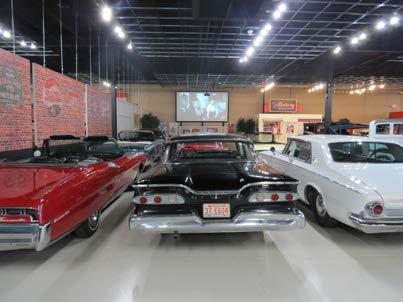

TRAVERSE CITY — Following a successful inaugural fireworks competition last year, organizers of the International Fireworks Championship presented by GFL Environmental announced today there will be an additional night and more teams competing in this year’s event.
The fireworks competition will take place Friday, September 6, and Saturday, September 7 at Turtle Creek Stadium in Traverse City. The show will feature pyrotechnic teams from Australia, the United Kingdom, India, the Philippines, Finland and USA.
Tickets for both nights of the show will go on sale Tuesday, May 14 at 11 a.m. at www. TraverseCity.com. 1,000 seats will be designated as two-night show ticket packages. Prices per night are $50 for box seats, $70 for field seats, tables for four are $500 and suites range from $1,000 to $2,500.
“This event features some of the top pyrotechnic teams in the world,” said Traverse City Tourism President, Trevor Tkach (Tah-koch). “Last year’s tickets sold out in minutes and the audience was mesmerized by the incredible artistic displays. This year will be even bigger and better.”
The teams are invited to compete if they have won other competitions from around the world. They have 15 minutes to stage their performance and are judged on design, synchronization to music, and the overall experience of their show. Best of Show awards will be given on both nights through votes by attendees. In addition, a group of pyrotechnic experts will present a juried award based on the teams’ performances for both nights of the event.
Teams this year include:
• Foti Family Fireworks of Australia, which is most widely known for producing the New Year’s Eve display in Sydney Harbor.
• Selstar Fireworks from the United Kingdom, has participated in multiple fireworks championships and won in Monaco, Lebanon, and other locations.
• Morani Fireworks from India, which presented at the Cricket World Cup and has displayed at musical performances with Justin Beiber and Coldplay.
• Blue Peacock from the Philippines performed for the King of Thailand, the Manilla New Year’s Eve celebration, and won the Casino du Lac-Leamy Sound of Light Show in Ottawa, Canada.
• JoHo Pyro Professionals from Finland won competitions in

Montreal, Cannes, and DaNang.
• Pyro Shows, based out of Texas, has performed around the world and conducted the 4th of July fireworks at the Washington Monument – featured on the PBS television show “A Capitol Fourth” - 13 times.
Fireworks competitions are rare in the U.S., but more common in Europe and other parts of the world. Each team is required to follow specific guidelines that challenge their creativity and artistic ability.
The teams say they are already deep into planning their shows. “The Traverse City International Fireworks Competition provides an even playing field as all competitors are working to the same criteria and even from the same pool of fireworks,” said Robert Foti, from the Australian team. “This allows us to experiment with design and soundtrack ideas. We can’t wait to see what everyone will do and can’t wait to display our show to the people of Traverse City.”
Details of the event, and a video that highlights last year’s International Fireworks Festival are available at: www.traversecity. com/internationalfireworkschampionship/


TBy Kathy Barnett Editor-In-Chief
he legendary Route 66, known as the “Mother Road,” begins in the heart of Chicago and winds its way through the Midwest, offering travelers a journey filled with history, nostalgia, and unique attractions. From the urban landscape of Chicago, through the farmlands of Illinois, and into the scenic byways of Missouri, this stretch of Route 66 takes you all the way to the Oklahoma line. Along the way, you’ll discover charming towns, iconic landmarks, and classic Americana that make this road trip one for the ages.
Begin your adventure at the eastern terminus of Route 66 in downtown Chicago, where the “Begin Route 66” sign marks the start of your journey on Adams Street. Before heading out, take time to explore some of Chicago’s most famous attractions. Visit Millennium Park and snap a photo with “The Bean,” or enjoy a deep-dish pizza at Lou Malnati’s Pizzeria. Once you’ve soaked in the city vibes, it’s time to hit the road.
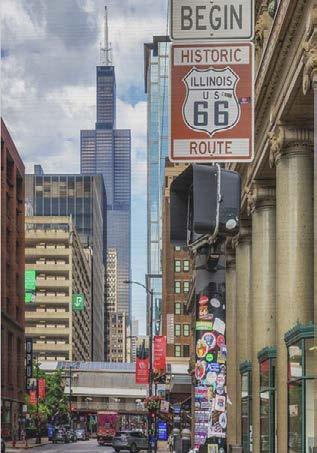
Just 45 miles southwest of Chicago, Joliet is your
first major stop on Route 66. The Joliet Area Historical Museum and Route 66 Welcome Center offer an engaging introduction to the road’s history, complete with classic cars and memorabilia. While in town, check out the Rialto Square Theatre, a historic venue with stunning architecture, and grab a treat at Rich & Creamy, where a neon sign of animated ice cream cones beckons.
Further along, the town of Pontiac offers a deep dive into Route 66 lore. The Pontiac Route 66 Hall of Fame & Museum is a treasure trove of artifacts and stories from the road’s golden era. Don’t miss the town’s colorful Pontiac Murals, which bring the history of Route 66 to life. The Pontiac Oakland Auto Museum is another must-visit, showcasing a beautiful collection of vintage Pontiacs.
Springfield, Illinois: Lincoln’s Legacy
Springfield, the capital of Illinois, is rich in history and a significant stop on your Route 66 journey. Explore the Abraham Lincoln Presidential Library and Museum to learn about the life and legacy of the 16th president. Springfield is also home to the Cozy Dog Drive-In, where the corn dog was invented—an essential stop for a classic Route 66 meal.

Crossing the Mississippi River brings you to St. Louis, Missouri, where the towering Gateway Arch greets travelers as the symbolic gateway to the West. Take a tram ride to the top of the arch for breathtaking views, then explore the Missouri History Museum to learn more about the city’s role in American history and its connection to Route 66. The Chain of Rocks Bridge, a unique Route 66 landmark with a 22-degree bend, offers a scenic and historic crossing of the Mississippi River.

Continuing west, you’ll find the small town
As you approach the end of your Illinois leg, stop in Litchfield to experience a slice of Route 66 history. The Ariston Café has been serving travelers since 1924, offering a taste of traditional American diner fare. Visit the Litchfield Museum & Route 66 Welcome Center to delve into the history of the Mother Road in this region.
of Cuba, Missouri, known as “Mural City.” The town’s vibrant murals tell the story of its history, including its role in the heyday of Route 66. Stop by Wagon Wheel Motel, one of the oldest continuously operating motels on the route, for a dose of nostalgia and a comfortable place to rest.
Rolla is a gateway to the beautiful Ozark Mountains and offers a mix of natural beauty and Route 66 charm. Visit the Totem Pole Trading Post, the oldest continually operating business
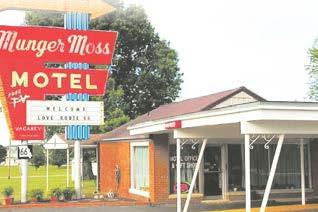
on Route 66 in Missouri, for souvenirs and a peek into the past. The town is also home to Stonehenge—a half-scale replica of the famous British monument, located on the Missouri University of Science and Technology campus.
As you continue toward the Oklahoma border, Lebanon is another iconic stop on Route 66. The Munger Moss Motel is a quintessential Route 66 destination, known for its vintage neon sign and nostalgic atmosphere. Be sure to visit the Route 66 Museum inside the Lebanon-Laclede County Library, where you’ll find an array of exhibits dedicated to the history of the Mother Road in Missouri.
The Queen City of the Ozarks
Springfield, Missouri, often referred to as the “Birthplace of Route 66,” is where the idea for the historic highway was first conceived. Visit the Route 66 Car Museum to see a collection of vintage vehicles that once cruised the Mother Road. Downtown Springfield offers a variety of dining options, including Casper’s, a beloved local spot known for its quirky decor and delicious chili.
Americana and Architecture
Carthage is a town steeped in history and charm, with its blend of historic architecture and Route 66 nostalgia. The 66 Drive-In Theatre offers a classic drive-in movie experience, complete with a retro concession stand and vintage
vibes. Don’t miss the Jasper County Courthouse, a stunning example of Romanesque Revival architecture that dominates the town square.
Last Stop Before Oklahoma
Before you cross into Oklahoma, Joplin is a must-see stop with a rich Route 66 heritage. Visit the Joplin History & Mineral Museum to explore the town’s mining history and its connection to the Mother Road. Take a stroll through Murphy Boulevard Park, where you can see remnants of the original Route 66 alignment.
For a unique experience, check out the Route 66 Mural Park, where two large murals celebrate the history of the road and its significance to Joplin.
As you leave Joplin and Missouri behind, Route 66 continues into Oklahoma, where new adventures and iconic stops await. The transition from Missouri to Oklahoma marks the end of one chapter and the beginning of another as you continue your journey along the historic Mother Road.
Traveling Route 66 from Chicago to the Oklahoma line is a journey through the heart of America, filled with timeless landscapes, historic towns, and a deep sense of nostalgia. Whether you’re retracing the steps of past travelers or forging your own path, this stretch of Route 66 offers an unforgettable experience that captures the spirit of the open road.
More on Illinois >HERE More on Missouri >HERE



What’s more Terrifying Than a Real Cave? Located eighty feet below ground in a real Limestone Cave! World’s Longest Haunt! Plus 30,000 live bats! Voted best Haunt in the USA by USA Today readers for 2018. WINNER of Best of Dayton, Consecutive Haunt of Year Award and “HOTTEST HAUNT GOING” by HOD reviewers. Voted Best of Ohio by Hauntworld best Actor & Climax awards among many others!
For thrill-seekers and Halloween enthusiasts, the Lewisburg Haunted Cave in Ohio offers an unforgettable experience that blends natural eeriness with spine-chilling entertainment. Located 80 feet below ground in a real limestone cave, this haunted attraction is renowned for being one of the scariest in the country. With over 500 feet of haunted hallways, visitors are immersed in a world of terror where live actors, elaborate scenes, and unexpected frights lurk around every corner. The cave’s natural darkness and cold, damp atmosphere amplify the fear, creating an authentic haunt-
ed experience that’s hard to match.
Open on weekends from late September through October, the Lewisburg Haunted Cave is the perfect destination for a Halloween-themed weekend getaway. Whether you’re a seasoned haunt-goer or a first-timer looking for a thrill, this attraction promises to test your courage. It’s more than just a haunted house—it’s an adventure deep beneath the earth that will leave your heart racing long after you leave. For more information, visit the website hauntedcaveatlewisburg.com. More on Ohio >HERE





By Sarah Miller Freelance Writer
Take your leaf peeping to a whole new level– in a treehouse. Cozy up with a fluffy pillow with the forest and birds at eye level. Think of sleeping in a treehouse as a childhood dream come true with all the built-in, adult comforts. Treehouses come equipped with luxuries like comfy sofas, wrap-around decks, grills, mini kitchens, and bathrooms.

Thanks to the Discovery Channel’s series Treehouse Masters, interests in tree houses soared among adults. The show brings people’s wildest childhood treehouse fantasies to life. In my home state of Ohio, Treehouse Masters Host and Designer, Pete Nelson and his team, have built several whimsical and wild treehouses that celebrate the natural world.
To sleep in a Pete Nelson designed treehouse village visit Cannaley Treehouse Village in Northwest Ohio. Part of Metroparks Toledo, the Cannaley Treehouse Village is the only public treehouse village in
the country. Here you’ll find themed tree houses, wooden ramps, cargo hammocks, and trestle bridges. This idyllic village is nestled in Oak Openings Metropark, a globally rare ecosystem listed as one of The Nature Conservatory’s 200 “Last Great Places on Earth.”
Each treehouse is themed, and the largest is The Stable, a six-person, equestrian- themed treehouse with two queen beds, a full bed, and a cozy couch. Looking for something smaller? The Nest is a bird-themed, two-person treehouse with a loft designed to look like a bird’s nest. Adventurers will
love The Dragline, a two-person spider-web concept with climbing structures, swinging chairs, and a slide. Or, ride into The Hub, an ADA-accessible, four-person, bicycle-inspired treehouse with a funky bike tire chandelier. The treehouse’s ramp leads straight to the onsite mountain biking path.
At Cannaley Treehouse Village, you’ll find people gathered around the community fire pit for s’more roasting. It’s not unusual to see a full-grown adult whizzing down a slide from the upper level with their child close behind. The village is playful, yet peaceful–a place
where a couple can relax on an elevated deck after a fall hike.
Just a short stroll from the village is HEAVY Wheelhouse, the place for locally-brewed beer and Black Kite Coffee. Food trucks and indoor/outdoor games make this a family-friendly place to unwind. The Wheelhouse also rents adult and childrens’ mountain bikes to try out the adjacent skills course or hit the trails.
With Oak Openings Metropark at your doorstep, that translates to recreation activities like mountain biking, hiking, fishing, and birding. As the largest Metropark in the area with over 5,000 acres to explore, it’s possible to traverse through oak savannas to wetlands to vegetated sand. Check out a free ranger-led program to better appreciate the surrounding beauty.
Those wishing to make their treehouse stay even more memorable can partake in special packages.
● Tree Climbing: Facilitated tree climb at the Treehouse Village
Climbing Tree.
● Mountain Biking: Guided 2-3 hour mountain bike adventure on the Beach Ridge Singletrack Trail.
● Maumee Kayaking Adventure: Self-guided paddle based out of the Farnsworth concession with transportation from Treehouse Village to Farnsworth.
● Guided Backpacking/Hiking Adventure: Guided hiking adventure within the Oak Openings Region. Transportation from Treehouse Village to hiking location and return trip provided. Campfire snack upon completing the hike.
● Romance Package: A dozen roses and a box of chocolates. This autumn, take in fall foliage in a fresh new way. Cool breezes, crackling fires, and brilliant color are waiting. Nothing compares to your own private, elevated deck created around existing trees. Breathe in the earthy, autumn goodness and listen to the rustling leaves. Head into the woods and sleep with the sounds of nature cradled in creature comforts.

Treehouses are popular, so book early. Check out Cannaley Treehouse Village, located in the Beach Ridge area of Oak Openings Preserve.
3520 Waterville Swanton Rd, Swanton, OH
metroparkstoledo.com/exploreyour-parks/cannaley-treehouse-village/
Actor Matthew McConnaughey mentioned his stay at The Mohican Treehouses on national television, making them even more sought after. Close to Mohican State park, an area known for canoeing and hiking, you’ll find ten authentic treehouses, two designed by Pete Nelson, treehouse designer with the Little Red Treehouse featured on Treehouse Masters. www.themohicans.net
22650 Vess Road, Glenmont, Ohio
Hot tubs in the trees? Yes, that’s what you’ll find here. These three luxury, pet-friendly cabins are tucked in the Hocking Hills region of Ohio known for waterfalls and rocky hiking trails. amongthetreeslodging.com/ the-clubhouse/
Hocking Hills, Ohio
Berlin Woods Treehouses
Majestic tree houses equipped with luxuries like fireplace, hot tub, and televisions make this a cozy fall escape in Ohio’s Amish Country. Less than a mile from Berlin, Ohio, visit shops and restaurants. 44654
www.amishcountrylodging.com/ berlin-treehouses
5331 County Road 626, Millersburg, Ohio





By Kathleen Walls Travel Writer
Roads.net
Route 66 was given the name American’s Mother Road by John Steinbeck in his 1939 book The Grapes of Wrath because it was the route for people fleeing the dust bowl. It’s still one of America’s most famous roads. It’s a long drive, so it’s best to pick some iconic places to “Get your Kicks on Route 66.” Here are some fantastic places along the middle of the Mother Road that I visited lately.
Fordson Hotel is a 135-room boutique hotel, which once housed the 1900s Fred Jones Ford Motor Company assembly plant that crafted Model Ts. So don’t be surprised to find a Model T in the lobby. The guest rooms feature high ceilings and large steel windows reminiscent of the 1900s. It’s on the National Register of Historic Places but it still has all the 21st century amenities, a spa with massage services, 24-hour fitness center, sauna and steam room, a business center, a laundry service if needed, and great free Wi-Fi. The hotel is pet-friendly. They offer complimentary shuttle service to locations within three miles. Parking costs extra, but street parking is hard to find and there are usually meters to feed.
Mary Eddy’s Kitchen and Lounge, named in honor of Fred Jones’ wife, provides upscale dining at the hotel. Pool Bar and Bodega offer lighter meals.
If you are a history lover, the early west is showcased here. There is an entire gallery is devoted to the culture of Native Americans.

Less serious history is here too. You can go back to the thrilling days of yesterday with the cowboys of the silver screen and ride the range with Roy and Gene. There are exhibits of Clint Eastwood’s Spaghetti Westerns. It has something for everyone. My favorite is Prosperity Junction, a recreated frontier village.
The Centennial Land Run Monument, the largest sculpture series in the world, is 47 largerthan-life bronze statues. It’s in a city park open to the public year-round. It commemorates the opening of the Unassigned Land in Oklahoma Territory with the Land Run of April 22, 1889. The detail is so realistic you expect the horses to gallop forward and the wagon wheels to turn. It was created by artist Paul Moore, whose great-grandfather participated in the Land Run.
Museum

Oklahoma History Center takes you through the state’s history from the Native Americans to present day. One of the most impressive exhibits is the Heroine Steamboat, which predates the romantic era of steamboats on the Mississippi. It was built in 1832 and sank on May 6, 1838, and was recovered from the Red River.
Another exhibit showcases the native peoples of Oklahoma from early days to contemporary American Indian cultures. Remember, for many years until 1907, Oklahoma was Indian Territory.
The most moving museum in Oklahoma City deals with one of the most horrific acts committed in modern history, the April 19, 1995 Oklahoma City Bombing. This museum walks you through the events when a terrorist bombed the Alfred P. Murrah Federal Building, murdered 168 innocent people, 19 of them children.
The Memorial Museum, housed in the former Journal Record Building on the corner next to where the bombed federal building stood, retells the story of what happened that day. It shows the little things so often overlooked, yet
sometimes the most poignant. Amid the crumbled rubble, a filled coffee pot remained on a table, almost untouched. A briefcase belonging to a woman coming to the federal building is displayed, making you wonder what brought her to her death that fateful day. Photos, informational placards and interactive exhibits tell the story of an event that should never be forgotten.
A portion of the building’s rubble is preserved behind glass, so you see the actual damage, not just exhibits. It’s a powerful reminder of the havoc one terrorist can create. The museum takes the visitor through the trials of McVeigh and his co-conspirators. Near the end, exhibits explain the trial. Investigations led to his co-conspirator, Terry Nichols. A third conspirator, Michael Fortier, escaped his just punishment with a plea deal and testified in exchange for a lesser penalty. The place where the Alfred P. Murrah Federal Building once stood is now the Field of Empty Chairs, Reflecting Pool and Rescuer’s Orchard.
A visit to The American Banjo Museum shows the banjo’s humble beginnings in this county with enslaved people playing the homemade
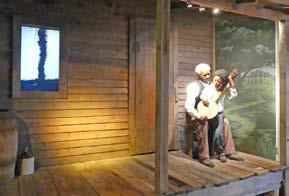
American Banjo Museum

banjos on the plantations and shows the beginning of public banjo performances in minstrel shows of the 1840s. Despite the political incorrectness of white musicians performing in blackface, this gained the banjo recognition as a professional instrument from white listeners.
As America moved into the 20th century, the banjo became accepted as a classical instrument. They show the improved instruments being produced by instrument makers. There are more than 300 jazz age banjos here: the most in any collection anywhere.
One banjo is a Vega Earl Scruggs Model fromwhen Earl Scruggs and Lester Flatt, played the classic theme song for The Beverly Hillbillies. A unique banjo was played by Kermit the Frog. When she was a guest on the Muppet Show, Julie Andrews started a tradition by signing the head of the banjo, and the tradition continued. It is signed by other Muppet guests, including Roy Rogers, Diana Ross, Johnny Cash, Gene Kelly, Peter Sellers, Elton John, and others.
Following such a historical route, it fits to stay in a historic hotel. The Fisk Building, an eleven-story building constructed in the mid-1920s during Texas’ oil-boom years, was originally built to house doctors and dentists. The First National Bank occupied a portion of the building from 1935 to 1951. In 2011, the building was converted to the 107-room Courtyard Amarillo Downtown, one of Marriott’s Courtyard hotels. It has all the comfort and amenities you expect from a Marriott hotel with the bonus of historic touches.

The Big Texan is food and fun, making you feel like you’re on a western movie set. There’s a life-sized windmill, a big cowboy, wooden swings,
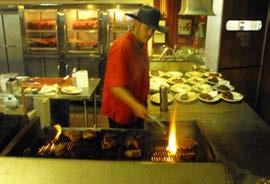
and a huge plastic bull out front with a sign offering “Free 72-Ounce Steak.” The dining room is classic Old West décor, with cowboy musicians roaming around playing requests. The massive grills have grillers turning out steaks at the speed of light, with a table right in front set for anyone wishing to try for that free steak.
If you want that “free” steak the sign promised, you must eat a 72-oz steak with all the trimmings, 3 fried shrimp, garden salad, baked potato and a dinner roll, in one hour. The most spectacular win was in April 2016 when Molly Schuyler, a 128 lbs young woman, tucked away three of the 72-ounce in 20 minutes. She broke all records and won a grand prize of $5000.
R. J. “Bob” Lee opened The Big Texan in 1960 on Route 66 and his sons, Bobby and Danny, carry on today. In 1970, he realized the new highway, Interstate 40, would divert much of the traffic from Route 66, so he moved the restaurant to its present location. With an onsite brewery and motel designed to look like an old western town, their latest addition is an RV park. For groups of four or more, you can ride in their black limo shuttle complete with bull horns.
Since the horse was Texans’ main transportation long before cars, start with the video in the Ken & Laina Banks Theater to learn the history of the American Quarter Horse. Get the “inside story” at the X-ray exhibit. You can’t help falling in love with “Doc” the vet and “Two Bits” the horse getting his checkup.
Panhandle Plains Historical Museum, a fantastic museum located on Texas A and M University Campus in Canyon, calls itself “The Smithsonian with a Texas accent” for good reason. It covers 14,000 years and 26,000 miles of Texas’ panhandle. It began as a bits-and-pieces museum during the Great Depression and continued to grow until it’s now the largest history museum in Texas, with over two million artifacts.
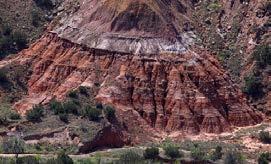
Panhandle Plains Historical Museum has Pioneer Town covering life in the Texas Panhandle from 1890 to 1910. You can see the village church or visit a Chinese laundry. The transportation section covers stagecoaches to classic cars. One of my favorites is the 1910 Zimmerman, one of the rarest of American-made autos, that really were horseless carriages made from old buggy parts. You’ll see lots of classic cars, the old Burma Shave Signs, and so much more.
Jack Sisemore RV Museum’s tucked away behind Jack’s RV sales and service. Step inside and you experience time travel. The jukebox, in a 1950s diner, is playing Elvis, Jerry Lee Lewis, or Fats Domino.
Stepping farther back in time, there’s a Lampsteed Kampkar, designed a kit to fit the Model T Ford chassis. Its rear compartment folds to become two double beds. Upright, the bed frame’s center section becomes a pair of bench seats. Then there is the big 1948 Flxible, that was used in Robin Williams’ movie RV. The nostalgia continues with a shiny like-new 1962 Airstream, the little aluminum 1946 Teardrop or the teensy red and white 1953 Fleetwood Travel trailer. As a longtime RVer, I was in heaven here. Palo Duro Canyon State Park
Texas doesn’t get outdone in the nature department. The 120-miles-long Palo Duro Canyon is
second only to the Grand Canyon in the United States. Once you enter the park, the views change from flatlands to fantastic canyons with amazing colors and shapes. Every formation is unique. There are hoodoos, mushroom-shaped columns of sedimentary rock jutting out of the canyon floor, and ruffle, called by early Spanish explorers “Spanish Skirts.” Early Spanish explorers named the canyon “Palo Duro” meaning “hard wood” because the area is filled with mesquite and juniper trees. The cliffs and formations are variations of reds and oranges with some buff mixed in. The mesquite trees are bright green and the juniper a darker green. Tiny flowers standing alone on barren sand or rock are very eye-catching.
Best place to start is at the Visitors Center. There is a museum of natural and historical facts about the canyon here. You can stay at the park’s campground or cabins. If you visit from June to August, you can see Texas, the state play of Texas, at the Pioneer amphitheater, carved in one of the canyon’s natural basins.
Hotel Chaco isn’t a historical hotel, but it has incorporated elements of ancient Chaco Canyon’s ancient structures do deeply influence the hotel design you feel you are visiting an ancient Aztec building. There are elements including precise stone masonry, vigas and latillas for rooftop structures and alignment with the sun’s rotation. The rooms combine the pale wood and Native American art to provide all the modern conveniences, so you have the best of two worlds. They were a winner in the 2023 Sunset Travel Awards “Where to Stay: Best City Stays” for travel in the West.
Hotel Chaco in Old Town, which takes you

back to 1706, where century-old adobe houses now are restaurants serving classic Mexican food, and tiny artisan shops selling jewelry, rugs and pottery made by locals. Old Town Plaza, overlooked by 18th-century San Felipe de Neri Church, usually has musicians playing old Spanish music on the gazebo.
Travel back farther in history to prehistoric New Mexico at nearby New Mexico Museum of Natural History and Sciences where you’re greeted out front by their resident dinosaurs, Alberta and Spike, a pair of realistic sculptures. The museum tells New Mexico’s story from the first multi-cellular life to the space age. One impressive exhibit deals with climate change.
The Albuquerque Museum is also in Old Town. It tells the story of Albuquerque with an artistic flare displaying painting and sculptures. It has traditional art, but there’s a lot more. From the culture of the Tiwa people who lived here once to the city’s contribution to the atomic age, you will find it here.
splitting of an atom to today’s uses of nuclear power. There’s an exhibit about Las Alamos and a model of “Fat Man,” the bomb we dropped on Nagasaki, Japan. Children will enjoy learning while having fun in the Children’s Section. Outside there’s a display of bombs and the planes that dropped them.
The Turquoise Museum is the place to go treasure hunting. It’s a treasure on many levels. Jacob Lowry, museum director and fifth generation in the family business, told me so much about the gem. The building itself is also a treasure. It looks like a historic German castle but was built in 2008 by Gertrude Zachary, a wealthy jeweler, who lived there until her death in 2013.
The museum’s collection contains some of the rarest and most expensive turquoise stones in the world. The museum helps you learn the history of turquoise, how to tell real from fake stones, and the art of cutting turquoise.

You can fly Albuquerque’s friendly skies in a hotair balloon, but first visit the Balloon Museum and learn the history of balloon flights from 1783 to present day flights. You’ll learn all balloons are not created equal. The museum takes you beyond balloons and has an exhibit on dirigibles and how they almost became the air passenger mainstay instead of airplanes.
There’s much more about the Nuclear Age at the National Museum of Nuclear Science and History where you will find “Pioneers of the Atom” exhibit. It’s a Smithsonian affiliate and the nation’s only congressionally chartered museum about the Atomic Age. The museum traces nuclear history from the first
Hot-air balloon flights are one of the main things Albuquerque is known for, so be sure to book a flight. When I visited, I took a Sunrise Flight with Rainbow Ryders. Operating since 1983, it’s the largest hot-air balloon company in the Southwest. Troy Bradley was the pilot and did a spectacular job of navigating. The views and sights are beyond words. Even though you
are high in the sky, there is no feeling of falling.
Learn Native American history and culture two ways at The Indian Pueblo Cultural Center. You are on Native American land here. Natives from 19 nearby pueblos perform traditional dances with a mixture of dance, costume, chant, and words that tell the story of their beliefs and culture. In the museum, the exhibits tell of New Mexico’s Native Americans from the earliest pictograms to modern-day tribal members.

The Bio Park is really three attractions in one; Aquarium, Botanical Garden, and Zoo. The Botanical Garden covers over 1.5 miles of paths through its multiple gardens: Old World Walled Gardens, Mediterranean Conservatory, Desert Conservatory, Camino de Colores, Rio Grande Heritage Farm, Sasebo Japanese Garden, Curandera Garden, Butterfly Pavilion, Railroad Garden, Children’s Fantasy Garden, Dragonfly Sanctuary Pond, Cottonwood Gallery, and the BUGarium. The outer gardens are mainly desert plants such as cactus and prickly plants, but inside the glass enclosed conservatory you’ll find beautifully colored flowers from all over the world along with desert plants.
By the Aquarium entrance, there’s a 1950 Hudson crossing over the Rio Grande that reminds you that you are on Route 66. The aquarium brings together historical and present-day aquatic life in the Rio Grande. It shows the problem of pollution on our sea life.
& Shores, South Pacific Gallery, Southern stingrays Touch Pools and the Shark Tank. There is even an exhibit that gives a glimpse of life on a shrimp boat.
Throughout the aquarium there are educational placards telling of the environmental damage things like plastics and oil spills are doing and steps we can take to help prevent the destruction of these precious life forms.
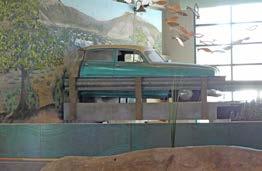
The aquarium is divided into many sections: Rio Grande at Central Bridge, Atlantic Coral Reef, Eels, Gulf Coast Gallery, Inside the Wreck, Jellies: Aliens from the Sea, Pacific Coral Reef, River Otters, Salt Marsh, Sea Turtles, Shallows
The zoo next to the Rio Grande was originally founded in 1927 as the Rio Grande Zoo. The 64-acre zoo is home to over 900 animals from around the world, including an Africa exhibit area, an Australia exhibit area, the Cat Walk and a herpetology area. They educate humans about the importance of conservation and sponsor breeding programs to help species survive. One of their latest achievements is the birth of a critically endangered ocelot kitten born July 8, 2024 to nine-year-old Lucy. Ocelots once ranged throughout the Southwest, but now South Texas is believed to be the only remaining native range of the fewer than 100 wild ocelots in the United States.

